

Unakoti – one of Tripura’s best-kept secrets
Tripura , Northeast India
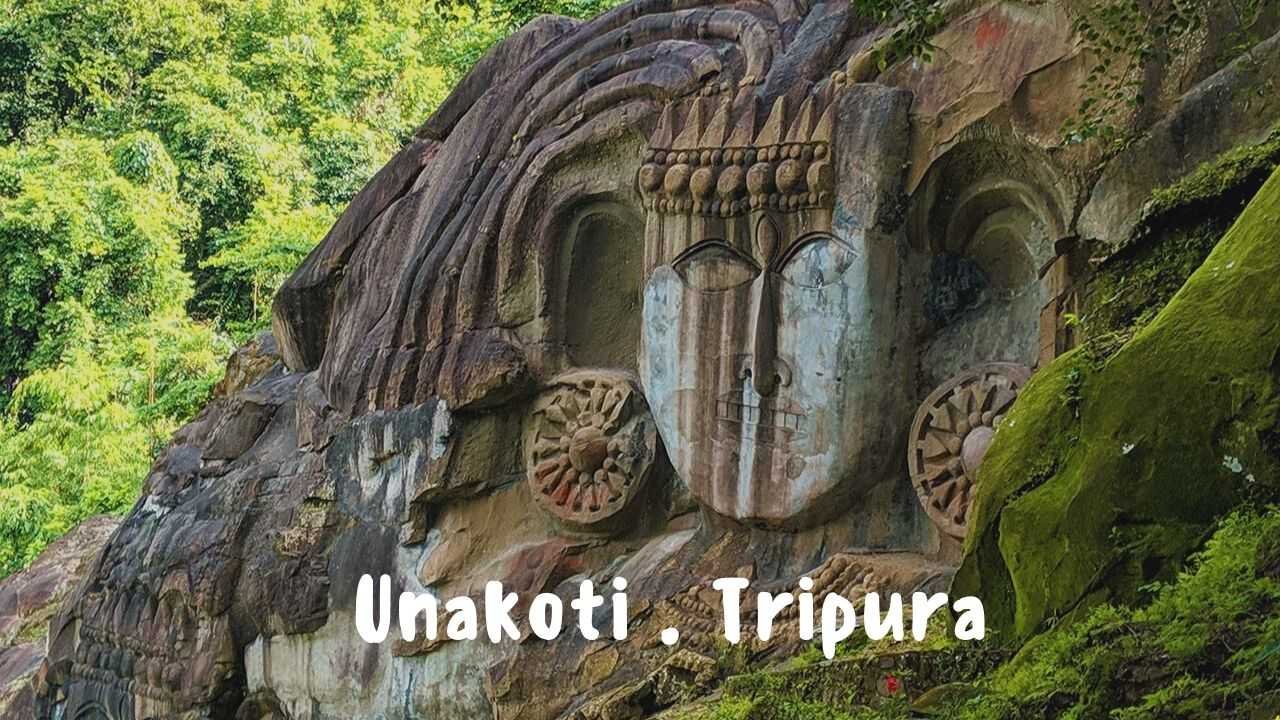
Last Updated on: Aug 25, 2021
Unakoti or Unokoti – the word itself has an aura of grandeur in it. Unakoti literally means “ one less than a crore ”. That is a huge number! Legend has it that the hills of Unakoti had one 99,99,999 rock-cut images of Gods and Goddesses. When I heard this for the first time, I knew I had to visit Unakoti in Tripura. Located on one of the parts of the thick forested Jampui Hills, Unakoti with its giant bas-relief structures is perhaps one of the most stunning heritage sites in South Asia.
Unakoti is located about 178km from Agartala, the capital of Tripura. This Shaiva pilgrimage is not something that you will find in India. The grandeur of Unakoti is surely going to take you in. who made these huge structures? Why were they made and when were they made? These questions will surely pop up. But a proper chronicle of Unakoti is still shrouded in mystery. Archaeologists assume that these stone bas-reliefs were made between 7th to 13th centuries. Infact they even claim that the sculptures belong to two different periods.
But where history and records fail, legends and folklore take the upper hand. Unakoti in Tripura has its share of legends. I have written about them later in the post.

So, what are bas-relief structures?
Bas-relief or low relief structures are a type of sculpture where the image is projected at a shallow depth. This technique was used in the art of ancient Egypt and other eastern cultures. Unakoti in Tripura is the example of one of the largest bas-relief structures in India.
We visited Unakoti during the month of October. The monsoons were just over and it was green all around. The weather was just as we wanted with the right amount of sun and warmth. After a rainy trip at Reiek in Mizoram , a sunny Tripura welcomed us.
We took a train from Silchar to Dharmanagar and reached there in the afternoon. Unakoti is about 20km from Dharmanagar and is an hour journey. So we decided to stay at Dharmanagar that night and visit Unakoti the next morning. The next morning we were on our way to Unakoti with a subtle excitement in our hearts.
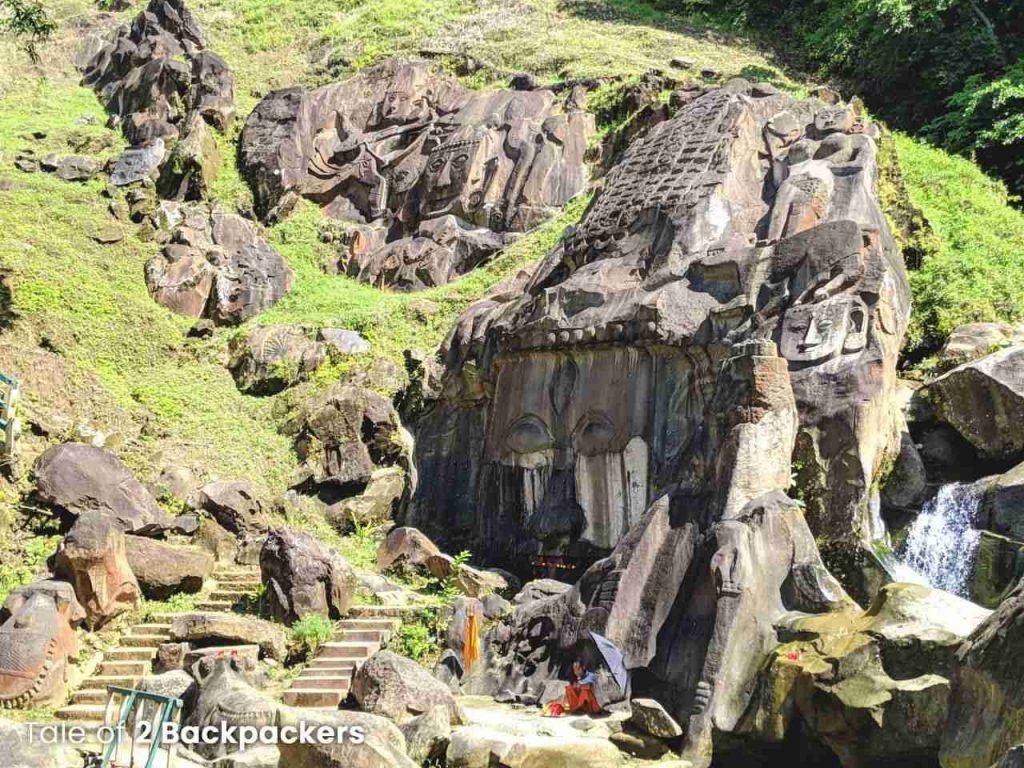
The road from Dharmanagar to Unakoti
The distance is only 20km. But the last stretch of roads is really bad. We had hired a car to visit Unakoti and the driver cribbed about the road conditions in those parts of Tripura. Apparently, the present government is not doing enough to build proper infrastructure in Tripura.
We were quite surprised at this because Tripura has some of the finest roads among the northeast states. The roads connecting Agartala to Udaipur were quite good. Yes, the last bit of road towards Unakoti was really bad with big potholes every now and then. But we both did not really care about the road conditions.
As our driver complained about road conditions and political issues, we simply enjoyed the landscape that was before us. We passed through tea gardens, beautiful villages, paddy fields and the Jampui forests. It was a pleasant ride when we saw a signboard saying Shivadham. Further down, there was another signboard saying Unakoti Eco Park, though nothing remained of the park. Anyways we realized that we were quite near our destination.
Finally, we arrived in front of a huge gate which had a face drawn on it, as if telling us what to expect beyond the barrier. Surprisingly there were no tickets to the site. We simply entered the area and followed the sign that said Unakoti Tirtha.
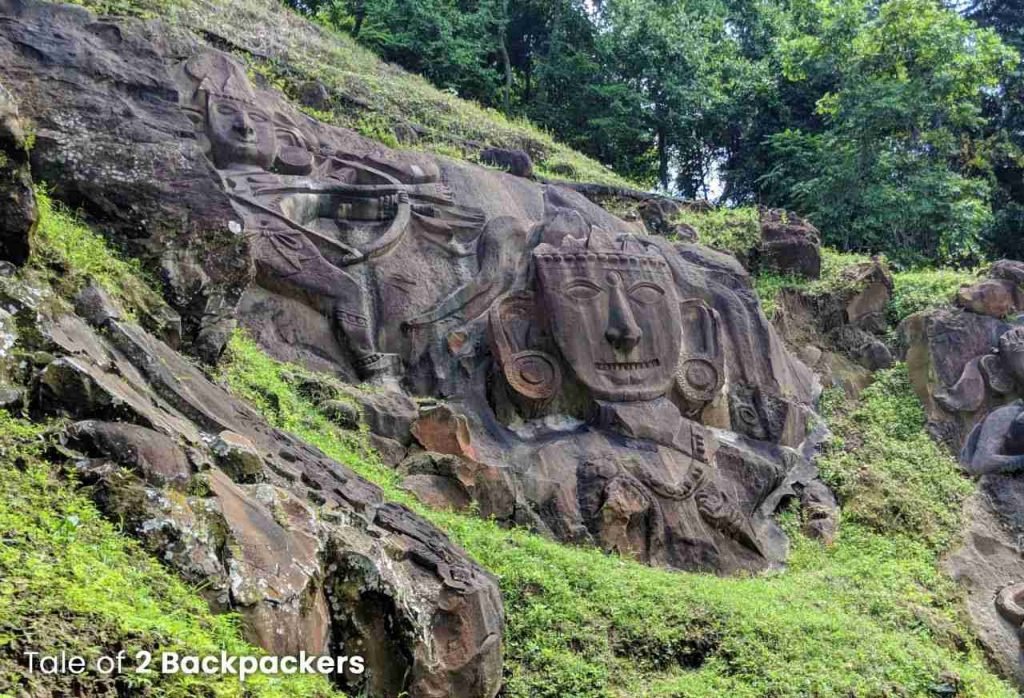
Our trip to Unakoti, Tripura
We seemed to be the only ones at Unakoti Tirtha at that time. There were a flight of stairs going down and we took them. After walking down a few steps we saw a huge face in front of us. It was as if the face was grinning at us. The entire cliff was carved like a face, almost 30 feet high. If I had not known Unakoti to be a Shaivite pilgrimage, I would have mistaken the face to be of the Buddha.
It had elongated earlobes and features like that of Buddha statue we had seen many times before. The face had a small crown and the ear was adorned with earrings. The hairs (that’s what it looked like) were radiating outwards. The first one had us totally mesmerized. Seriously, we had not seen anything like this before.
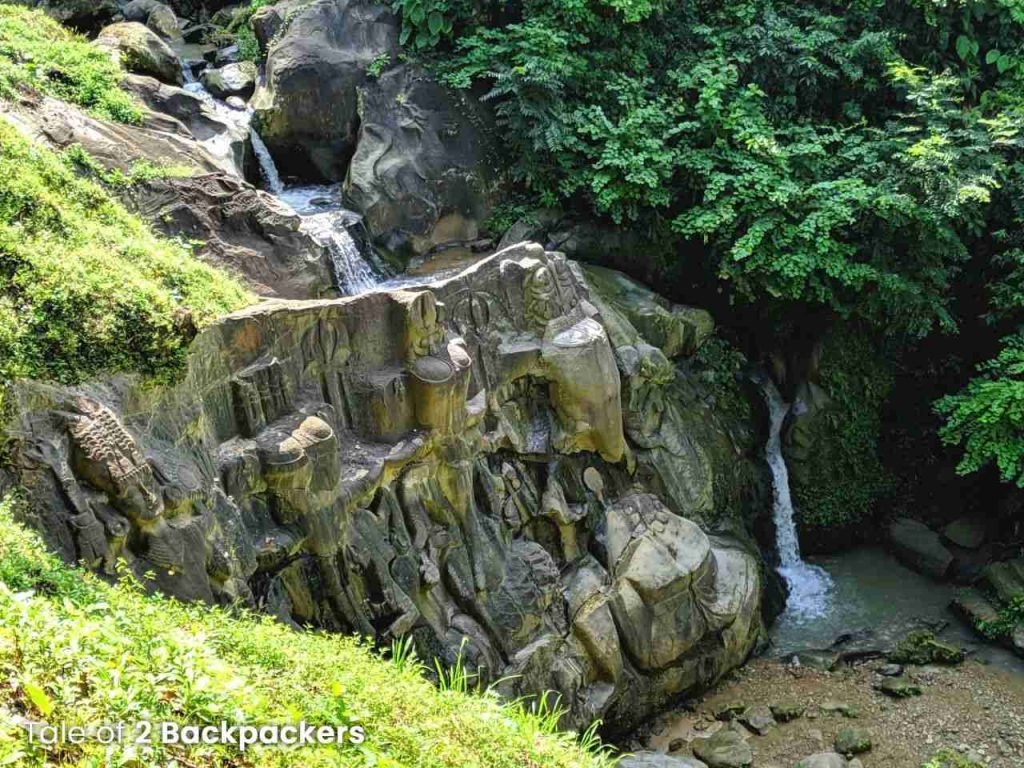
A few steps ahead, there was another face, which was quite similar to the previous one. Just beside that was a small waterfall, more like a stream. This small mountain stream is known as Dhaluchhora . Next, the trail bifurcated and we took the one towards the left. We followed the path where Dhaluchhora flows further down the valley. A few hundred feet below, there is another cliff face with another waterfall flowing down.
On the cliff face is the huge bas-relief structure of Ganesha . Beside the Ganesha were a few other sculptures of probably Vishnu. The Ganesha looked humungous with a potbelly and menacing look. It is said that during the monsoon, the waterfall actually flows on top of Ganesha head, thus bathing Lord Ganesha.
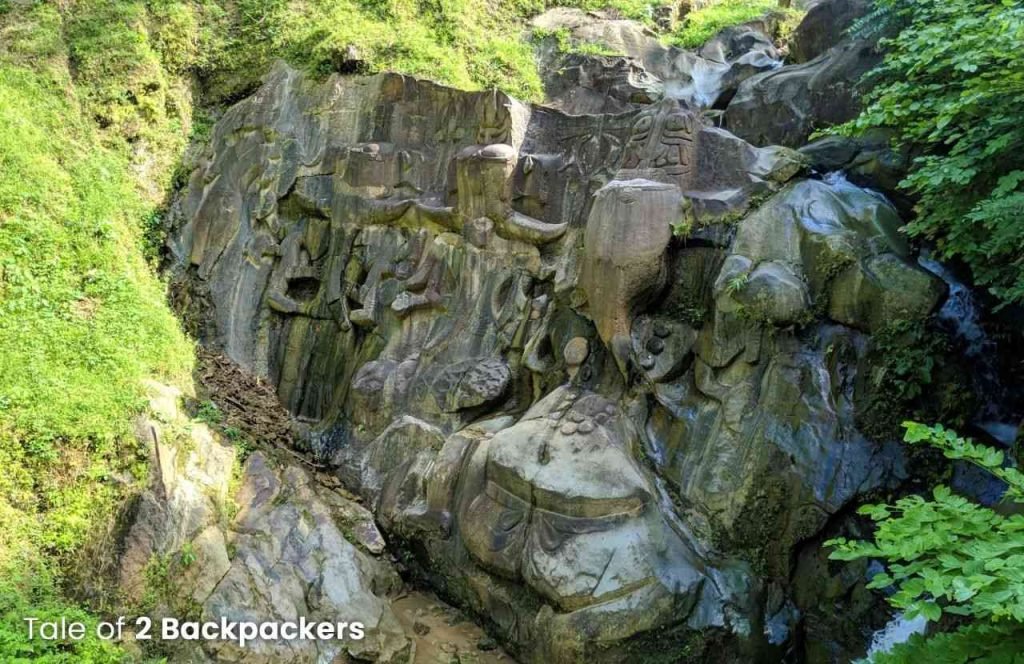
Further down, there is a landmark saying Chaaturmukhalinga Kalyansundaramurty . We followed that direction through muddy trails covered with vegetation growth. After five minutes’ walk and we were in front of a statue that had the same sculpture on all the four sides. Well, if you are keen to explore the place, you can visit this site. Otherwise, this one can be skipped.

Next was our turn to take the steps uphill. We went all the way up and there was a small locked room. It had a few statues that were perhaps excavated from the Unakoti site. They lay down there without any care.
There are many other panels and bas-reliefs in the gigantic gallery of Unakoti. The most famous one is perhaps the gigantic image of Lord Shiva, known as Unakotishwara Kal Bhairava . The image is about 9 metres or 30 feet in height. It has an elaborate headdress that takes up almost one-third of the entire relief.
Lord Unakotishwara is flanked by images of Goddesses on both sides. At both sides of the headdress are two female figures. They are perhaps the images of Ganga and Yamuna (I am not sure, many works of literature suggest that the image is of Ganga sitting on top of Capricorn or Makara ).
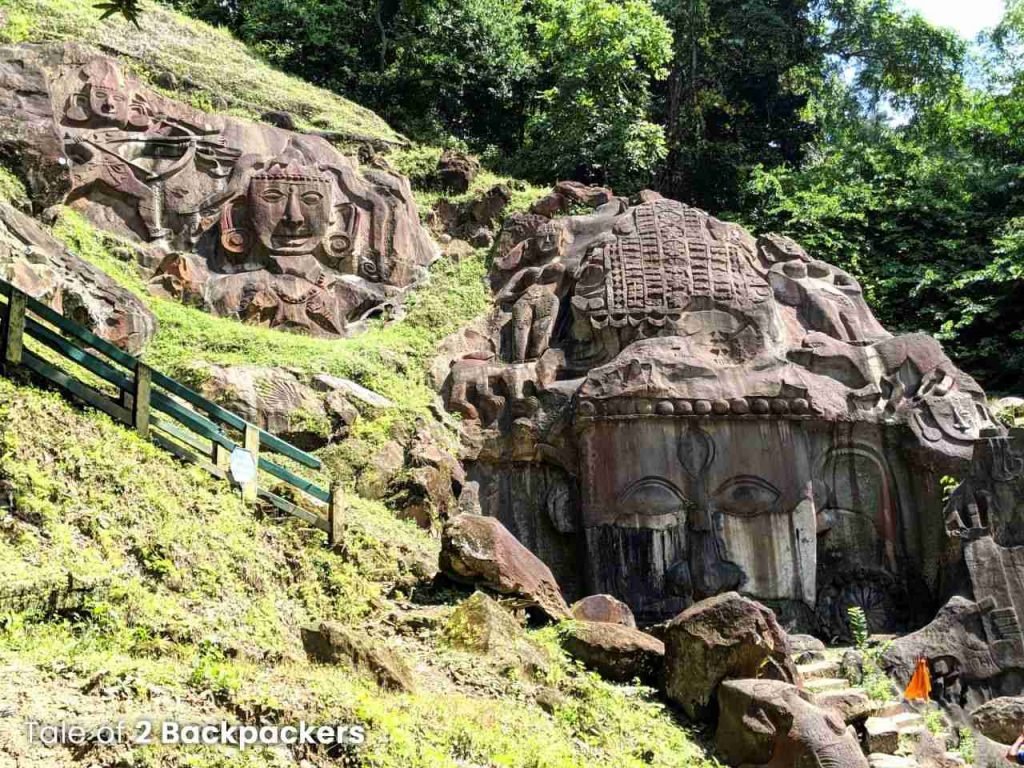
There is another bas-relief of a warrior-like goddess a little further up. This one is perhaps Goddess Durga standing atop her vahana lion. Near this panel, there are a number of scattered boulders that have its own images. Further up, right where the steps end there are images of two female figures on stone. It looks as if they are dancing. And yes, they have the same grin on their faces like the other images!

There is also a sculpture of Nandi bull just before the image of Lord Shiva. If you come down a bit further and cross the bridge, you will see a huge face lying down and looking up at the sky with a huge grin. This stone relief perhaps had fallen down on the stream years ago. And now it seems that the god is looking up to the heavens and grinning in glee.
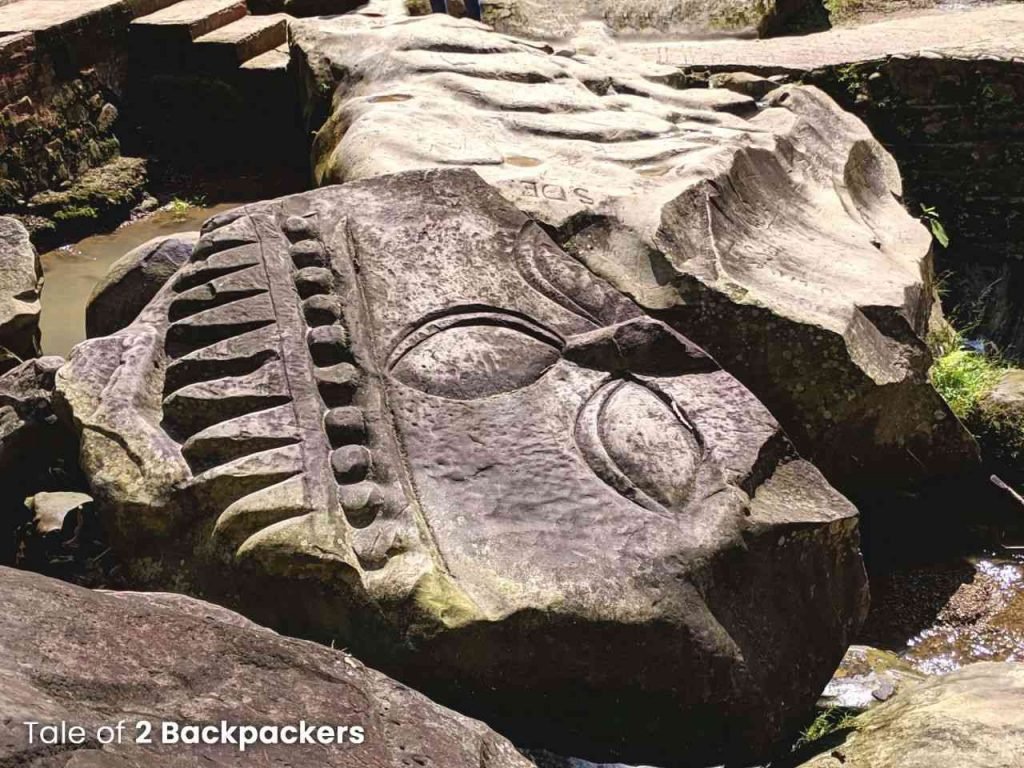
Myths and legends of Unakoti
Unakoti has been a site of Shaiva pilgrimage for more than a thousand years now. Since there are almost no historical records about these incredible bas-relief structures, myths and stories have grown more and more around this place. We heard about 3 of them and write them down for you.
Legend of Unakoti | When Gods overslept!!
Once upon a time, Lord Shiva with his entourage of Gods and Goddesses were in his way to Kashi, the ancient city of light. There were one crore or 10 million of them. On their way, Lord Shiva decided to stop at the Raghunandan Hills for the night. But before going off to rest, He asked the other 99,99,999 Gods and Goddesses to wake and be ready before the sunrise. After all, they have to cover a long distance to Kashi. Come next dawn, other than Shiva, all the others were fast asleep.
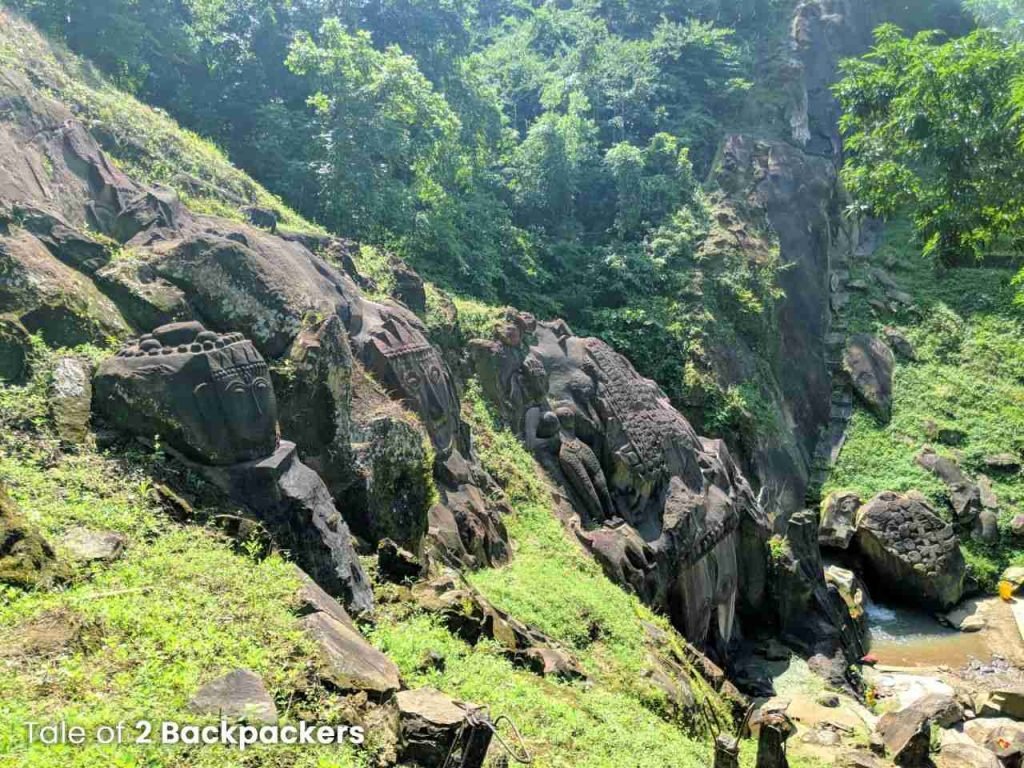
Shiva is known for his anger. On seeing that the rest of them did not pay heed to his words, his third eye opened. For the uninitiated, it is said that Lord Shiva has a third eye on his forehead and it opens only when he is extremely angry. At that time, heaven save the one on whom Shiva is angry! Coming back to the story, Lord Shiva cursed all the other Gods and Goddesses and turned them into stone. The stone images of ‘una-koti’ or one less than a crore Gods and Goddesses are thus said to be found on the hills of Unakoti.
But then the question arises, why are there so many images of Shiva at Unakoti? Well, this is completely rhetoric and you can think about the answers as you walk up and down the stairs looking at the huge sculptures on stone.
Almost all the ancient temples and religious sites have some folk, myths and stories about them. Unakoti also has a few of them. The one I mentioned above also has a version that says the entourage was going towards Kailash. I believe this one is the most famous one. The Board outside the site also narrates this story.
Legend of Unakoti | Making of one crore sculptures
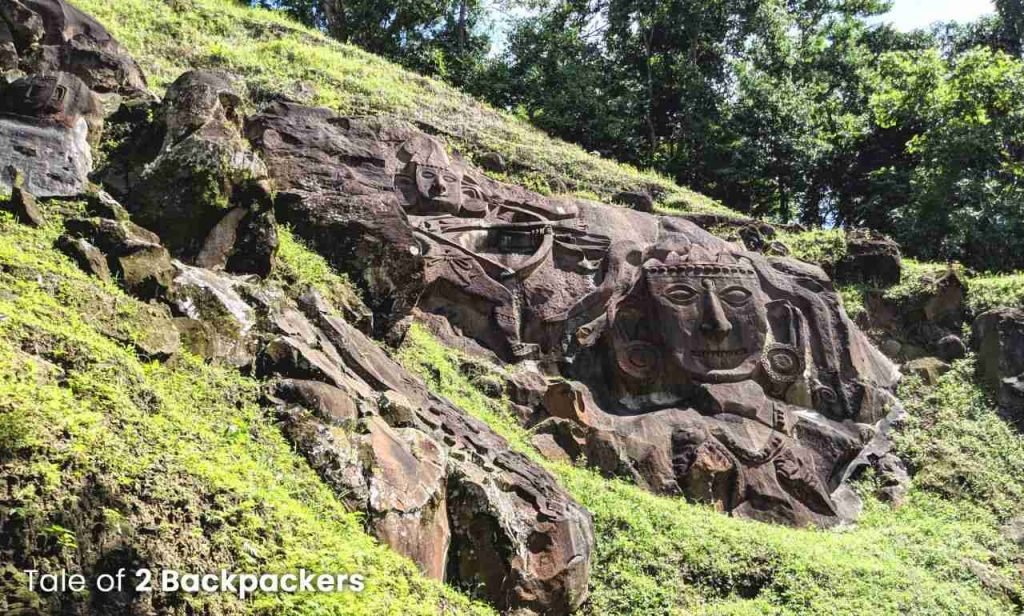
There is another legend about how Unakoti got its name. According to this story, the sculptures were done by one local sculptor called Kalu Kamar. He was a great devotee of Goddess Parvati, consort of Lord Shiva. So when Lord Shiva and Goddess Parvati were passing through the area, the devotee prayed to his devoted to taking him to Kailash, the holy abode of Lord Shiva. But the gods were reluctant to take him to their heavenly abode. So they came up with a plan. So Goddess Parvati asked him to make one crore sculptors of the Gods and Goddesses appease Shiva. Little did they know that Kalu Kamar was an artist of extraordinaire. Before the dawn, he had already made 99,99,999 sculptures.
Lord Shiva became worried that the mortal sculpture would complete the task. So he asked the cock to crow just before the usual time. Hearing the cock crow, Kalu Kamar was extremely disappointed. He stopped his work then and there thinking that it was already dawn. He missed his task by one sculpture. And the place came to be known as Unakoti. Sometimes Gods also have to resort to tricks it seems.
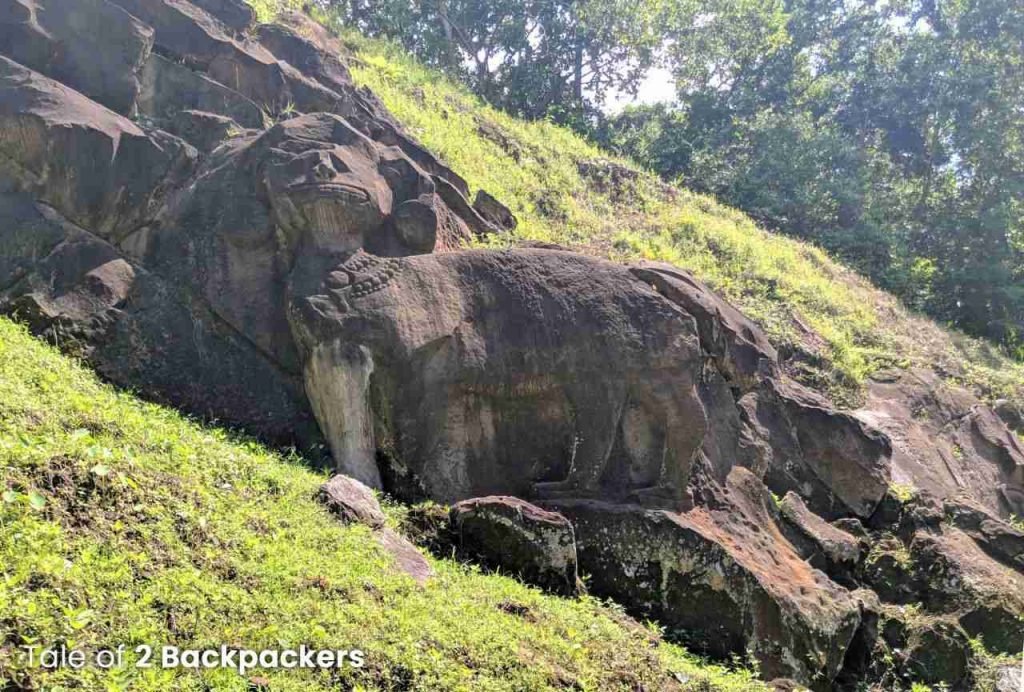
Legend of Unakoti | Arrogance has a fall
In another version of the story, it says that Kalu Kamar was given the task of making one crore sculptures of Gods and Goddesses. He became so arrogant on completing this extraordinary feat. The last image he made was of him instead of God, because by then he considered himself to be someone very important. Thus the name came to be Unakoti. It is said that his act angered the Gods and he was later struck down by divine power.
Legend of Unakoti | The legend of Subrai Khung
This one is more of a local Tripuri legend and the most prevalent among the local people of Tripura. Unakoti is also known as Subrai Khung . King Jujaru-Fa, also known as Hamtorfa was the first king of the kingdom of Tripura. His name meant Purushottam or the best of men. He established the kingdom of Tripura and made present-day Udaipur as its capital.
The people of Tripura were worshippers of Lord Shiva, who lives at Kailash in the snowy Himalayas. According to Tripuri legend, Subrai or Shiva is the dynastic god or creator of the universe. So King Hamtorfa wanted to bring Lord Shiva to his kingdom. He went to the Himalayas for penance and prayed to Lord Shiva. God was pleased with him and asked him what he desired. To this, Hamtorfa pleaded Shiva to come to his kingdom. Lord Shiva told him to go back to his kingdom and pray to all the gods and goddesses. He also advised the king to make statues of the gods, and then the gods and goddesses will reside in Tripura.
King Hamtorfa returned and prayed to all the gods and goddesses and made their statues and thus the deities came to reside in his kingdom. Only when he prayed to Goddess Ganga, she told the king that she will not be able to come down to Tripura. Because if she did so then rest of India would dry up. So she sent River Gomti to Tripura instead. The king did not construct the image of Ganga and so he was left with one less than a crore statues. These myths have been popularized by Rajmala, the chronicles of Kings of Tripura.
Well, Gomti River is the most important river of Tripura feeding all its villages and plains. I personally find this one to be more relatable to the place and people.
History of Unakoti
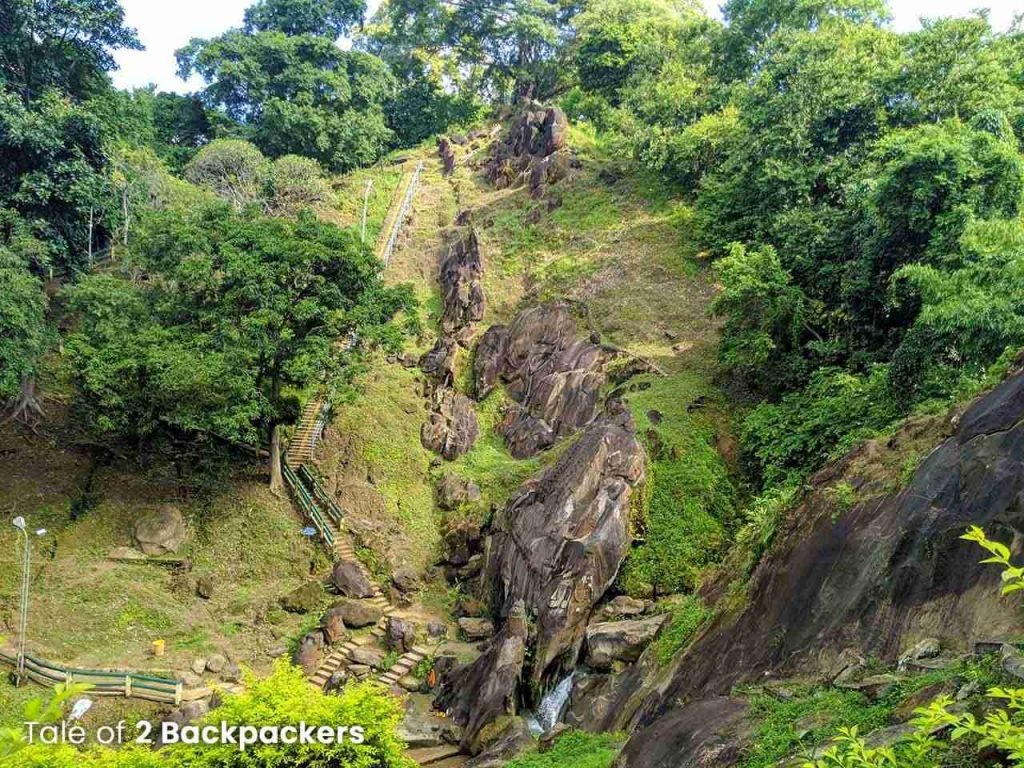
Whatever be the myths and stories behind Unakoti, it is really a mystery as to how and when these bas-relief structures were made. Archaeologists suggest that these bas-relief structures were probably made between 8th to 13th century AD. The sculptures were also perhaps built at different times. There is also speculation that this spot might have been a sacred place for the local Tibeto-Burmese tribe. During this period northern Tripura was a part of Srihatta, which was a renowned seat of Buddhist and Hindu tantrism. This area was also a crucial point of overland trade routes between eastern India and Burma, Thailand and Cambodia. Apart from the sea route, this overland route was also responsible for the transmission of Buddhism and Hinduism to Southeast Asia. But all these facts are not substantiated by any evidence. According to an assessment made by the Archaeological Survey of India (ASI) it is speculated that there might be still many reliefs and structures hidden in the hills and the forests. Not all is discovered yet. Well, we think that can be quite possible. Infact, the same thought came to my mind when we went to see the reliefs of Chhabimura. The closest historical fact that we heard about Unakoti was that it was a memorial to the legendary chieftain Subrai, whose chosen deity was Shiva.
Legends and myths are interesting. They make a seemingly boring place very much interesting. Unakoti in Tripura in itself is a very interesting place. The bas-relief structures are cut on the Raghunandan Hills are simply awe-inspiring and jaw-dropping. Yes, I am using these decorative adjectives for the place, but they really deserve them and much more
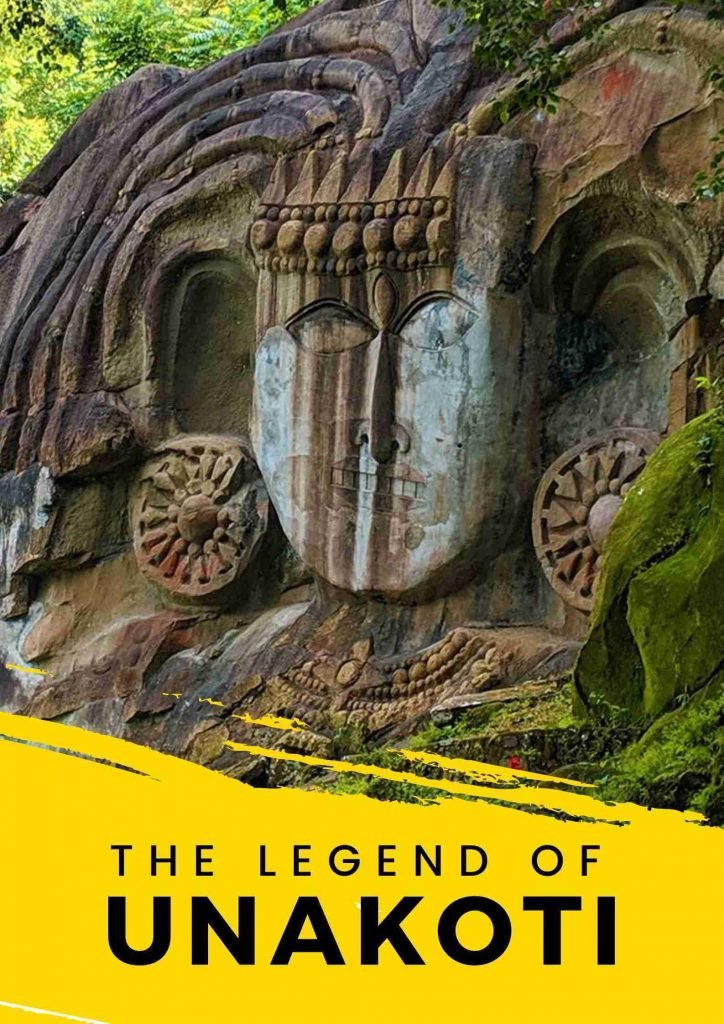
Unakoti, Tripura – Are there really one crore gods?
Unakoti is an extremely beautiful place. Hidden behind the numerous trees, the huge stone carvings invoked a sense of wonder in us. Well, you will not find 1 crore images there. That would have been too vast, too epic. There are a few such rock-cut carvings and those are enough to amaze us.
Enough of myths and legends. Now let us get into some practical stuff.
Where is Unakoti Located?
Unakoti is located about 178km from Agartala between Kailashahar and Dharmanagar in North Tripura. Unakoti is about 10 km from Kailashahar and 20 km from Dharmanagar. The Unakoti Hills, also known as Raghunandan Hills is actually a part of the Jampui Hills located in northern Tripura.
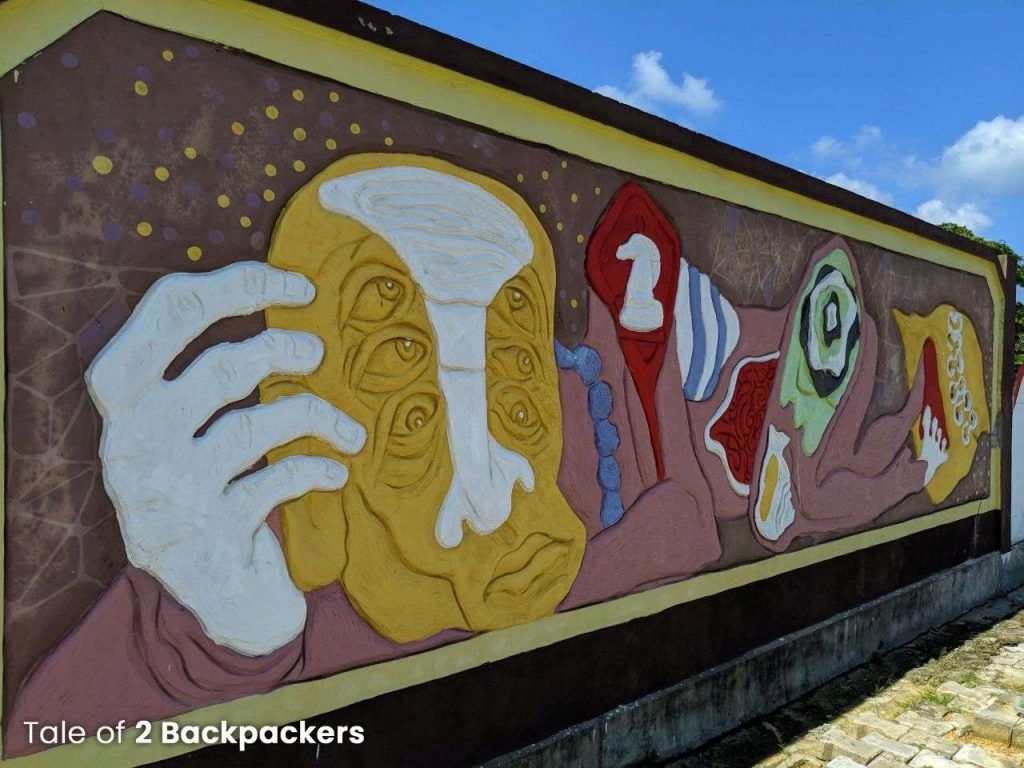
How to reach Unakoti?
As I said before, Unakoti is located between Kailashahar and Dharmanagar. Both are important towns in Tripura and located more towards the Assam border. You can visit Unakoti from either Agartala or from Silchar side as well (like we did).
Unakoti from Agartala
If you have come for a trip to Tripura, you will probably arrive at Agartala first. In that case, you can take a bus from Agartala to Dharmanagar or Kailashahar. From both the towns, you will get shared vehicles to Unakoti. You can also hire a vehicle to Unakoti. Tripura is one of the northeast states that is very well connected by trains. You can also take a passenger train from Agartala to either Dharmanagar or Kumarghat . Kailashahar is nearer to Kumarghat. Train travelling in Tripura is cheap and comfortable.
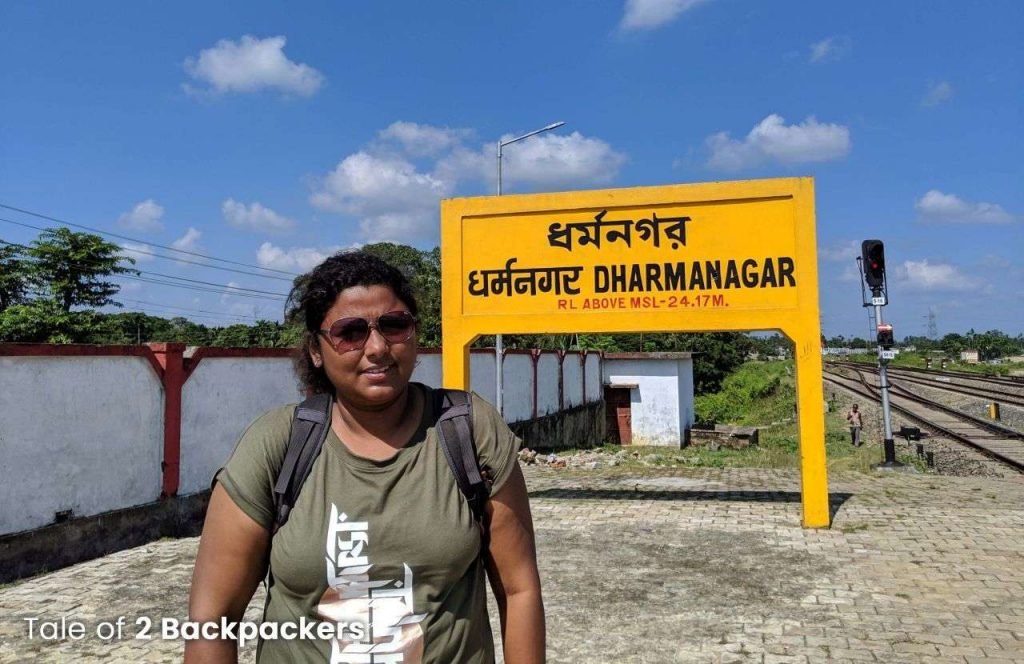
Silchar to Unakoti
If you are coming from Assam, like we did, you can take any train towards Agartala and get down at Dharmanagar. We were coming from Silchar after our Mizoram trip and took a morning train from Silchar to Dharmanagar. We reached Dharmanagar by 12:30PM and took a hotel for the night. We visited Unakoti the next day.
To reach Unakoti, we hired a car (Alto 800) from Dharmanagar. It took Rs1000 for a round trip and dropped us to Dharmanagar Railway station for our onward train journey to Agartala. The road was in a pretty bad condition after the rains. At one point, our car got stuck in the mud and we had to do a lot of manoeuvring to get it back on road!
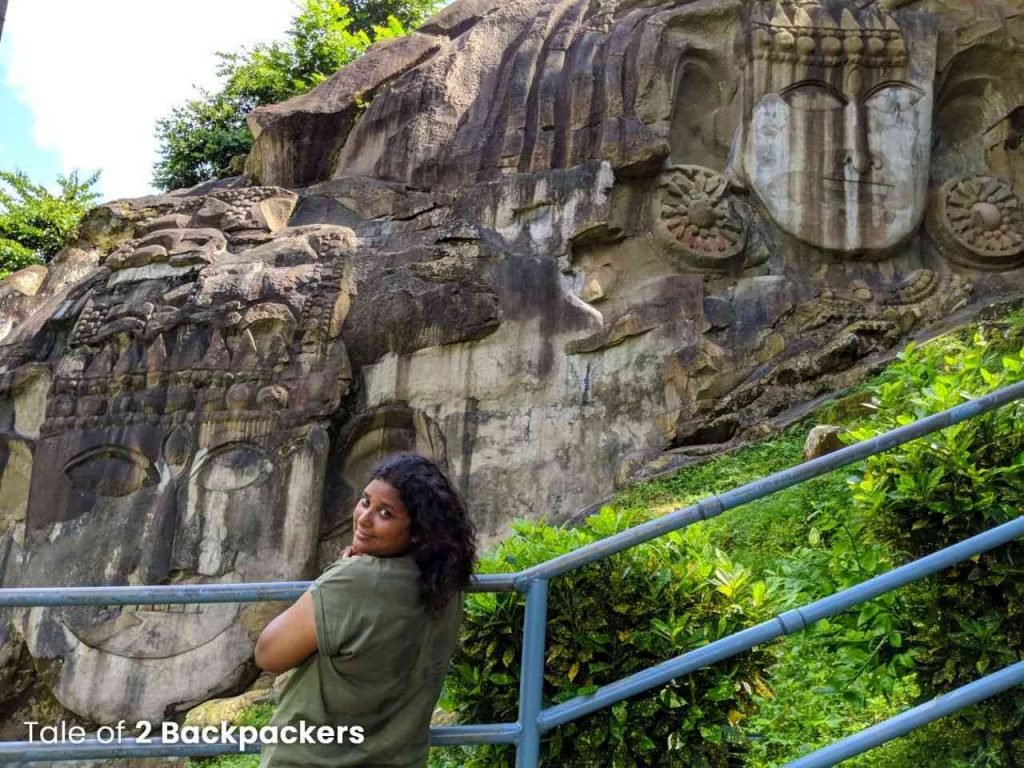
Where to stay?
You can either stay at Dharmanagar or Kailashahar. There is a Tripura Government Tourist Lodge (Unakoti Tourist Lodge) at Kailashahar. Unakoti is about 10km from the tourist lodge. The rates are quite reasonable too with Rs800 for a double-bedded room and Rs950 for a deluxe AC room.
There are a number of hotels and guest houses at Dharmanagar as well. We stayed at Dharmanagar in Hotel Panchabati. It was a decent hotel with Rs1200 for an AC double bedded room.
Is there any entry fee in Unakoti?
No there is no entry fee at Unakoti.
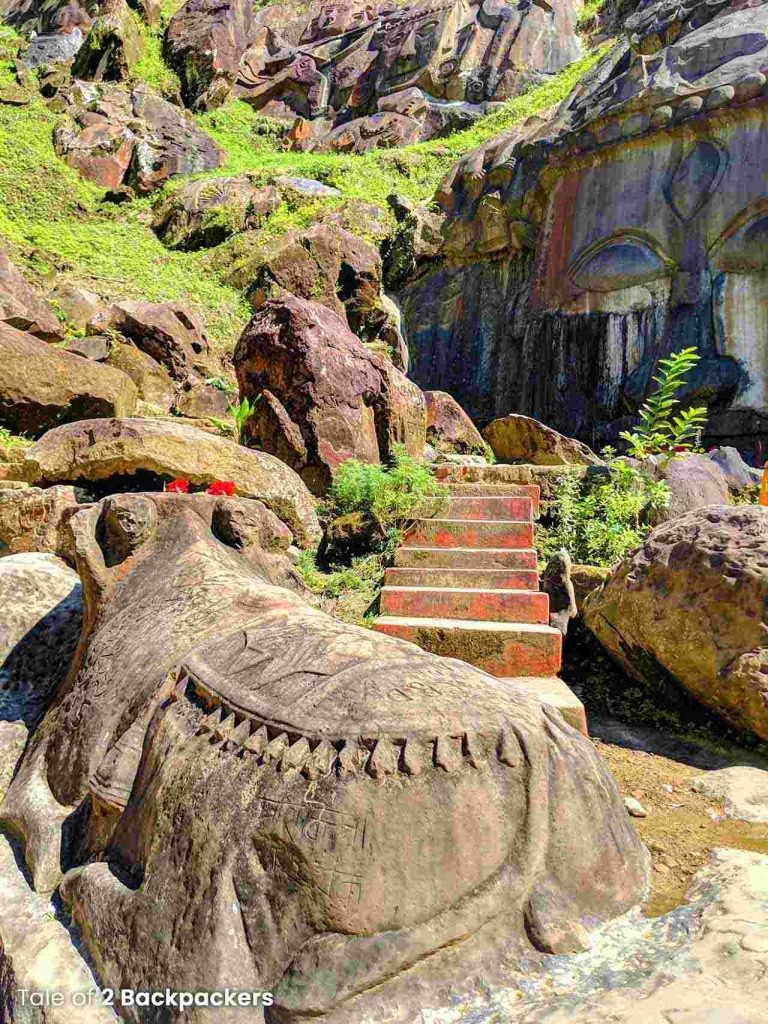
Some important Tips
- Wear comfortable shoes. There will be a lot of walking and climbing stairs. So be prepared for that.
- Wear comfortable and light clothes for the same reason.
- Visit early or in the late afternoon. Late afternoon will be good for photography lighting. We visited in the morning and the light was in the opposite direction.
- Carry a water bottle with you when you visit Unakoti.
- There are no proper shops near Unakoti site. What we found was a small shop selling tea and some eatables.
Unakoti in Tripura can be of great importance, both in terms of history and tourism. It is sad that the government is still oblivious to the place. Although I have to say that Unakoti is at least more popular than the other wonders of Tripura. A study into Unakoti can perhaps provide answers to several ethnocultural questions. Lately, we heard that Unakoti was being considered for getting a World Heritage Status. Hope that this actually works out. It will provide the required boost to both tourism as well as historical studies.
Did you like the post? Please share it so that others can also know about this beautiful place. Pin this for a later read!
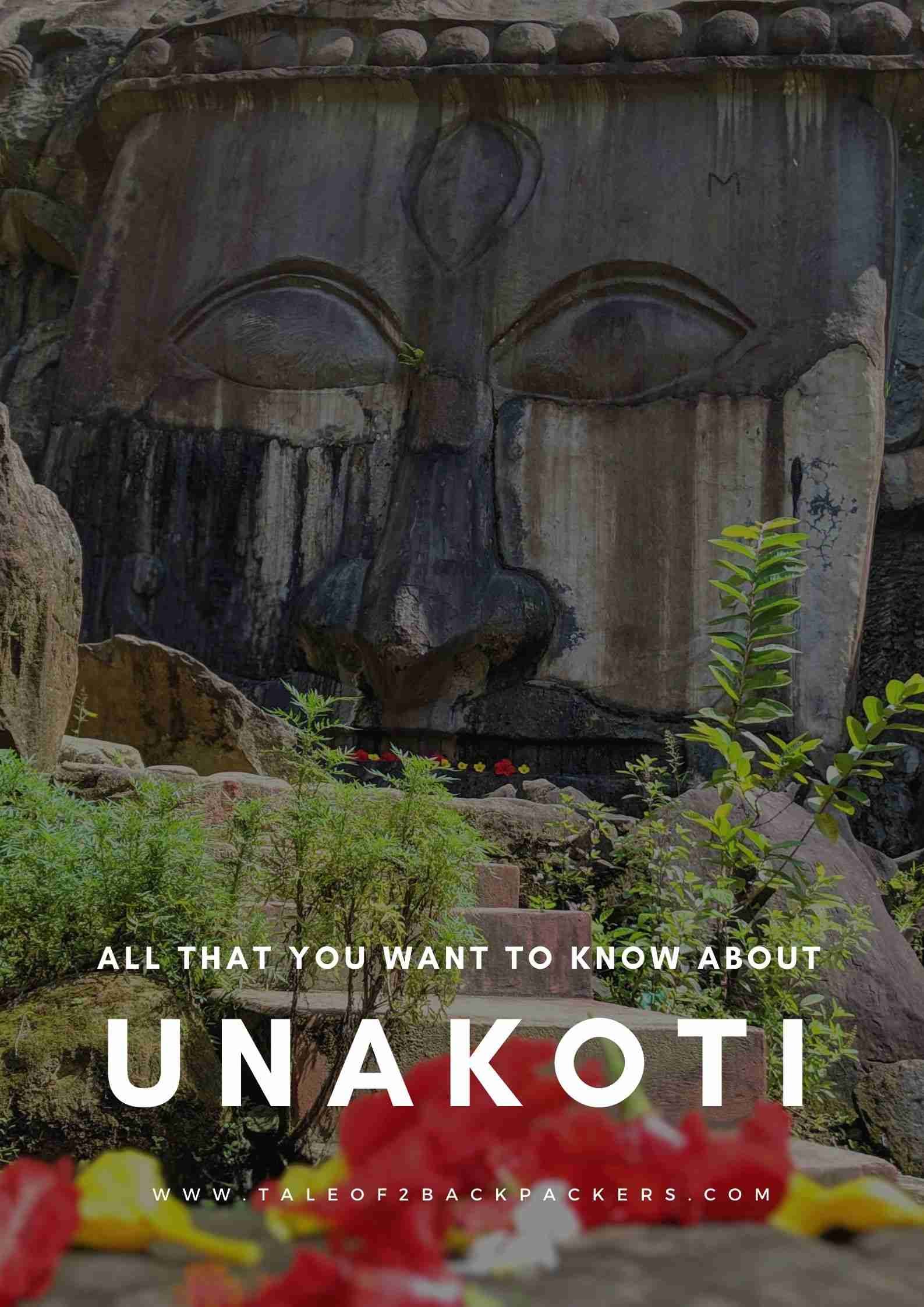
Agni Amrita
Related posts.
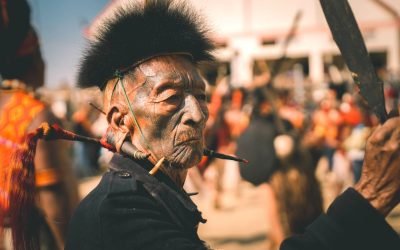
Aoling Festival at Nagaland – The Grand Festival of Konyak Nagas
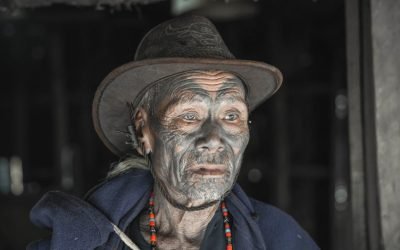
Konyak Tribe – In Search of The Tattooed Headhunters of Nagaland

Garo Hills, Meghalaya – Travel Guide for Your First Time Visit

Phe Phe Falls – Most Jaw-dropping Waterfall in Meghalaya
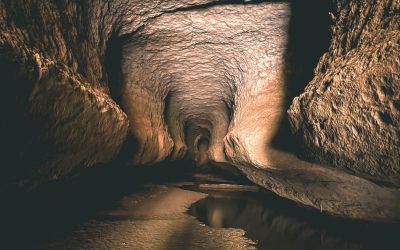
Siju Cave & Rock Formation – Nature’s Play at Garo Hills Meghalaya

Wari Chora – Hidden Paradise in Garo Hills of Meghalaya
22 comments.
Hey.. can i visit Unakoti from Agartala in a day and back to Agartala?? How much time did you spend in exploring Unakoti??
Yes, you can do Unakoti trip from Agartala in one day. We had spent around 4 hours exploring Unakoti.
Amazing post , Amrita. Thank you so much. We are driving from Guwahati to Unakoti this weekend . We are also taking my 60 y/o mother in law with us. I want to know if it is feasible for her to comfortably explore the entire site ?
Thank you so much Vaishali. Unakoti has a lot of stairs. Whether she can explore the place will depend on her level of fitness. Nevertheless, she can sit around (maybe near the Unakotishwar sculpture) if she is unable to climb up and down the stairs much!
I learnt about Unakoti a couple of months back and I absolutely fell in love with the stone carvings. I am in awe of Ganesha’s sculpture. I want to believe in the legendary story of Unakoti and see and discover the sculptures of all the 9999999 Gods and Goddesses. Guess, I will be spending a lot of time on the premises when I visit Unakoti.
Unakoti is absolutely stunning. I am sure you will have a wonderful time there.
I must admit even though I spent a large part of my early life in India has never heard of this magical place. Posts like these show us places that are less known about and not promoted as much . Unakoti is truly one of the most stunning heritage sites in South Asia. The stone art is just unparalleled to anything i have seen . I do try and visit these places early in the morning avoiding the crowd and the heat at times. I would love to try out the Tripura Government Tourist Lodge. Thanks for sharing
I know! Even after staying in India, we hardly know about many beautiful places. And thats the beauty of travel. We get to know about so many such places!
I’ve never heard of Unakoti but it looks amazing. I’d love to explore this area and see all those incredible stone carvings. It must have been so interesting to learn about all the myths and legends surrounding this place. What a great find.
Thank you Paul!
Wow good to know about Unakoti or Unokoti through your post as I never knew such place. You are true that the word has an aura of grandeur in it and as it means one less than a crore. Good to know about the legend of Unakoti where the hills had one 99,99,999 rock-cut images of Gods and Goddesses. The gigantic image of Lord Shiva – Unakotishwara Kal Bhairava really looks worth admiring. Thanks for sharing a hidden gem.
Thank you Yukti! There are so many stunning places that we dont know about. Unakoti is absolutely gorgeous.
What an incredible site to visit. Imagine that there were truly that many images carved into the rocks! I know very very little about Tripura itself, let alone about this site of Unakoti but would love to explore.
Thank you Kavita! Unakoti is a true gem. I am sure you will love exploring this place.
Such a cool place to visit. How incredible to see all the carvings in the stone. It must have taken great talent to create it. Thanks for the tip about visiting in the afternoon for the better photography lighting that is always something that is important to me.
It was truly an incredible place. We loved it.
Unnakoti is one hidden gem that u just uncovered in your blog.. and what a lovely place which goes almost unnoticed from the tourist radar . I will surely now make a plan to visit Unnakoti and other places around it .
You must visit Unakoti and Tripura as a whole. We should plan a trip sometime.
I can see why you would want to visit Unakoti to see the rock-cut images of Gods and Goddesses. So fascinating to see that they weren’t carved all on walls but on what appears to be any flat surface they could find. I am sure that the giant image of Lord Shiva was stunning to see. The warrior-like goddess almost looks like something from outer space. Always interesting to hear the different stories about sites. I am not sure that one person could possibly have created this massive and stunning site. Definitely a spot for a travel wish list. Pinned for future reference.
Thanks Linda! Unakoti was absolutely brilliant and so full of stories.
It is so interesting to read about a city in your own country that you have absolutely no knowledge about. The east part of India is truly unexplored and it’s a shame that I haven’t been there either. It is a very interesting article about a historical site in Tripura that I was very unaware of the existence of. I also did not know what bas-relief structures are. The story behind Unakoti, of the arrogant architect who built the structure of himself instead of God and was struck down by divine forces, is really intriguing too!
Thank you Medha. India has so many hidden treasures and Unakoti is one of them.
Submit a Comment Cancel reply
Your email address will not be published. Required fields are marked *
Submit Comment
This site uses Akismet to reduce spam. Learn how your comment data is processed .
Pin It on Pinterest
Unakoti Tourist Lodge

View prices for your travel dates
- Excellent 0
- Very Good 2
- All languages ( 7 )
- English ( 7 )
" Best you find and alternative and not stay here unless you have no other choice. Accommodation in Dharamnagar may be a better. "

" front rooms give a view of the lake.Other rooms in the back face a slum "

" Always go for a/c room else insect will ruin your day and night. "
Own or manage this property? Claim your listing for free to respond to reviews, update your profile and much more.
Unakoti Tourist Lodge - Reviews & Photos
View Hotels For Your Date
Unakoti travel essentials.
Ideal duration: 1 day
Best Time: October to Apr Read More
Planning a Trip? Ask Your Question
"Your trek to Indian Mythology"
Unakoti tourism.
A prime tourist spot in Tripura , Unakoti is an ancient pilgrimage centre, attracting tourists and devotees from far and wide.
Unakoti is where India's heritage stores its carvings and sculptures of gods and goddesses. For such a storehouse of religious and spiritual importance, it is only justified that the place also be the house to lush green flora and full of natural beauty. Many of the rock carvings here depict the life of Lord Shiva as well as other instances from the Hindu Mythology. Sculptures of the Nandi Bull, Lord Ram , Lord Ganesha , Lord Hanuman and Lord Ganpati can also be seen here Unakoti also makes a good place for hiking, trekking and other activities given the terrain and the natural offerings of the area.
Things to do in Unakoti
1. unokotiswara kal bhairava.

Nearby Places

How to Reach Unakoti
How to reach overview, how to reach unakoti by flight, how to reach unakoti by road, how to reach unakoti by train, local transport in unakoti, unakoti photos.

How To Reach Unakoti
Faqs on unakoti, what is famous about unakoti, what is not so good about unakoti, who should visit unakoti, what is the best time to visit unakoti, what is the local food in unakoti, what is the best way to reach unakoti, what are the places near unakoti, have a question on unakoti.

Unakoti Reviews

Similar Places

Get the best offers on Travel Packages
Compare package quotes from top travel agents
Compare upto 3 quotes for free
- India (+91)
*Final prices will be shared by our partner agents based on your requirements.
Log in to your account
Welcome to holidify.
Forget Password?
Share this page
Unakoti Tourist Lodge

View prices for your travel dates
- Excellent 0
- Very Good 2
- All languages ( 7 )
- English ( 7 )
" Best you find and alternative and not stay here unless you have no other choice. Accommodation in Dharamnagar may be a better. "

" front rooms give a view of the lake.Other rooms in the back face a slum "

" Always go for a/c room else insect will ruin your day and night. "
Own or manage this property? Claim your listing for free to respond to reviews, update your profile and much more.
UNAKOTI TOURIST LODGE - Reviews (Kailashahar, India) - Tripadvisor

Unakoti: The Pilgrimage of Tripura
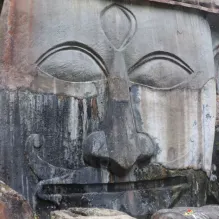
- Northeastern_India
“Unakoti” meaning “one less than crore”. It is the prime tourist spot of Tripura in the Kailashahar Subdivision. It is Shiva pilgrimage and dates back to 7th- 9th centuries and if not earlier.
It is nestled in between natures beauties with lush greenery surrounded by hills and forest. The place is peaceful and worth spending time seeing around the sculptures of many God and Goddesses by curving a rocks.The legends are quite interesting and there are mainly two stories go with it. According to the first myth, Lord Shiva was traveling to the holy city of Kashi (Varanasi) along with one crore Gods and Goddesses and he chooses Unakoti as a place for night halt. Lord Shiva instructed everybody to get up before sunrise the next day for an early start. Come dawn the next day and Lord Shiva found that he was the only one awake. This had angered him and he had cursed all others to turn into stone images.
The other myth goes like this. There was a local artisan and potter called “Kallu Kumhar” who was an ardent devotee of Lord Shiva. Upon his fervent prayer and insistence of Parvati, Shiva agreed to fulfill his wish of going to Kailash, the abode of Shiva & Parvati. But he put one condition to his grant. He had to sculpt a koti (one crore) images of Shiva, Parvati, Nandi, Ganesha and other gods and goddesses in one night and must finish before the first rays of sun hits the earth. Kallu Kumhar , took the challenge and worked on like a man possessed. But as luck would have it he was still short of one image when the ray of sunlight touched the earth thus his hope of visiting Kailash in person remain unfulfilled.
Unakoti is great in its own rights. Seeing the scenic beauty I was mesmerized and took a deep breath looking at it from the entrance. I tried counting the sculptures while seeing around but I was lost seeing its unique and noticing the distinct Tribal influences in the sculptures of God and Goddesses. It was really a rare piece to explore and understand the curving beauty. The faces, the ornaments and everything around has a subtle hint of Tribal art.
At the bottom, the falling of spring water was dominating the scene and also the center point of attraction is obviously the huge face of Lord Shiva known as “ Unakotishwar Kal Bhairab ”. This is a vast sculpture of just the face of Lord Shiva on the vertical rock face, with three eyes and a gigantic decorated head gear. The head is measuring 30 feet including the 10 feet tall headgear would be one of the largest that are found in India.
The Unakotishwar Shiva is worshiped daily and a priest stays there. Flowers were strewn in front evidencing regular flow of the devotees. Further down the hillock as I climbed down the long stone steps for some forty to fifty meters, another set of interesting sculptures emerged in front of my eyes.
There were the famous ‘Ganeshas’ of Unakoti. On the vertical rock face which looked almost gallery like wall. There are three imposing Ganesha curved out of the rock. On the right a gigantic image of a seated Ganesha with four arms. The dress has amazing details with the knot at the belly seemed almost lifelike. There are two more standing Ganesha statues on the left. The one in the middle is a Sarbhuja (six armed) Ganesha with three tusks and the one on the left is an A sthabhuja (eight armed) Ganesha with four tusks.
It cannot be said with certainty as who had taken the pains to create sculptures of this magnitude. Some of the traces are fading away, even the some of the sculptures are broken due to changes in weather. According to the ASI board, it could be assumed that Unakoti flourished as a great Hindu pilgrimage place for over 300 years.
How to reach:
Unakoti is about 190KMs from the state capital Agartala and its a five hours journey from there if you hire a cab to Kailashahar or Dharmanagar from Agartala.
Swasti Travels :09774913917 (car rental travel agency)
Otherwise from Agartala one can take a train to Kumarghat station on the Agartala Railway station. But beware this train timing. Another best way to travel is by bus from Agartala which would take close to six hours. Roads are single lane, but manageable by a small hatchback. Kailasahar is the closest town and Unakoti is about 8 KMs from Kailasahar. Dharmanagar is another prominent city which is 22 KMs away. From Dharmanagar or Kailasahar hire a private car to take you to Unakoti as local transport like bus is not easily available.
Where to stay:
There are many hotels if you are staying in Agartala. I can suggest some:
Hotel welcome palace
Hotel Sonar Tori
Ginger Hotel
You can either stay at Kailashahar or Dharmanagar. Unakoti has ‘Unakoti Tourist Lodge’ run by Tripura tourism. At Dharmanagar you can stay at ‘Uttermegh Tourist Lodge’ or at “Hotel Pachabati” which is a good private hotel offering comfortable AC rooms. This is nice, clean and conveniently located. Since accommodation is limited it is wiser to go with prior booking.
Where to eat:
There are no interesting cuisines or eating places to recommend around this region. But you may some small shop on the way to Unakoti where you can find “atte ke roti” , “seasonal sabji” or “egg burji” which is a light meal and its good to have light meal while we travel. Or else carry handy some fruits or sandwiches or anything light you prefer and also do not forget to carry water bottles.
Best time to visit:
September to November, February to April
Thank you for reading it. Happy to share about it. I will be coming up with more interesting things next time.
Related Post
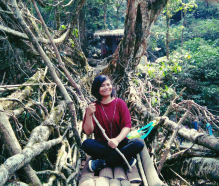
Fascinating journey to double-Decker living root bridge: Meghalaya Fascinating journey to double-Decker living root bridge: Meghalaya
A living root bridge is formed by guiding the young roots of the tree across a stream or river, and then allowing the roots to grow and strengthen over time
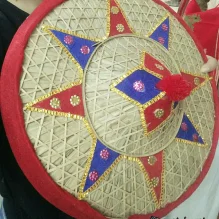
My Mellow Rhythm in Assam My Mellow Rhythm in Assam
Assam state is known for its wildlife, archeological sites and tea plantations. In the west (lower Assam), Guwahati, largest city, features silk bazaars and the hilltop Kamakhya Temple.
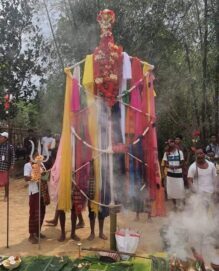
The mightiest deity of Jamatia : Baba Garia The mightiest deity of Jamatia : Baba Garia
Lord Garia, the deity of livestock and wealth, is worshipped with flowers and garland. It is celebrated as 'Garia Puja' during the month of April (Baishak).
Travel WordPress Theme Copyright 2023 @ Rupa: The Wanderer
India’s Ancient Unakoti Rock Carvings – Tripura Tourism
Have you heard of the Angkor Wat of the Northeast of India – the ancient Unakoti Rock Carvings in the state of Tripura?
In this article, you will know about the Unakoti Rock-Cut Sculptures. I visited Unakoti on the 9th of July, 2023.
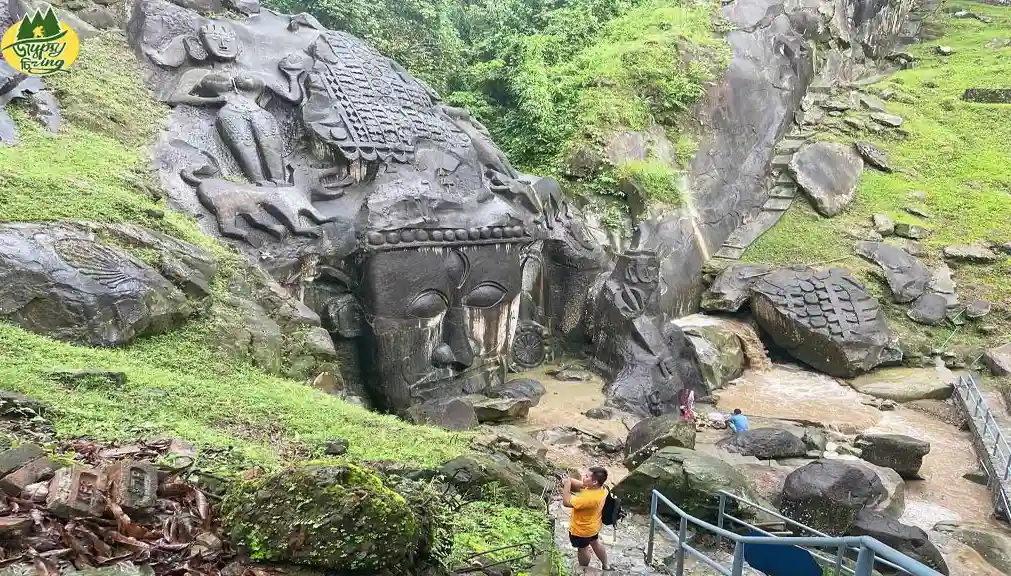
Before I share the rock-cut sculpture of Unakoti, let me tell you more about Tripura and its Unakoti District.
Table of Contents
About Tripura & Unakoti
Tripura is a state in the Northeast region of India. It shares 84 per cent of its border with Bangladesh. The states – Assam and Mizoram are located on its eastern border.
Kokborok, Bengali, Mogh, Chakma, Halam, Garo, Bishnupriya Manipuri, Manipuri, Hindi, Oriya and English are the languages spoken in Tripura.
Unakoti is a district in Tripura. It was previously a part of the North Tripura District. Unakoti district was formed in 2012 with its district headquarters as Kailashahar.
The Unakoti Rock Carvings
Unakoti Rock Carvings is an ancient place that hosts several mesmerizing rock sculptures. It is located about 8 km from the nearest town Kailashar in Tripura.
The sculptures at Unakoti belong to the Hindu deities and are dedicated especially to the worship of Lord Shiva. The name ‘Unakoti’ means ‘one less than a crore’ in the Bengali language.
These rock-cut structures are found mostly in the vertical walls of Unakoti hills (Raghunandan hills) and in the fallen boulders. Apart from that, a few small and medium-sized loose sculptures are also scattered around the hill.
In December 2022, Unakoti was added to the tentative list of UNESCO’s World Heritage Sites .
What is the story behind Unakoti?
Though the existence of Unakoti dates back around the 7th – 9th centuries. One of the story of Unakoti, according to Hindu mythology is when Lord Shiva was on his way to Kashi he halted for a night at this location accompanied by 99,99,999 Gods and Goddesses. He had asked them to wake up before sunrise and make their way towards Kashi.
Unfortunately, when the sun rose none awoke, except Lord Shiva. Before he set out for Kashi alone, he put a curse on the others, turning them to stone and that is how the site got its name UNAKOTI which means ONE LESS ONE CRORE.
Apart from this mythology, Unakoti holds several interesting legends and folklore which you can read in the article by Tale of 2 Backpackers .
My Personal Experience of Visiting Unakoti
Visiting Unakoti after I temporarily moved to Agartala was a long due on my bucket list. But, I never had the opportunity to do so until my cousin Esther got a job in July at a school in Churaibari. Churaibari is 10 km away from Dharmanagar town.
On the third day of my stay in Churaibari, three of us – my aunt, Esther and I set out to visit the famous site of Unakoti. We headed towards Dharmanagar town and hired a cab all the way to the archaeological site.
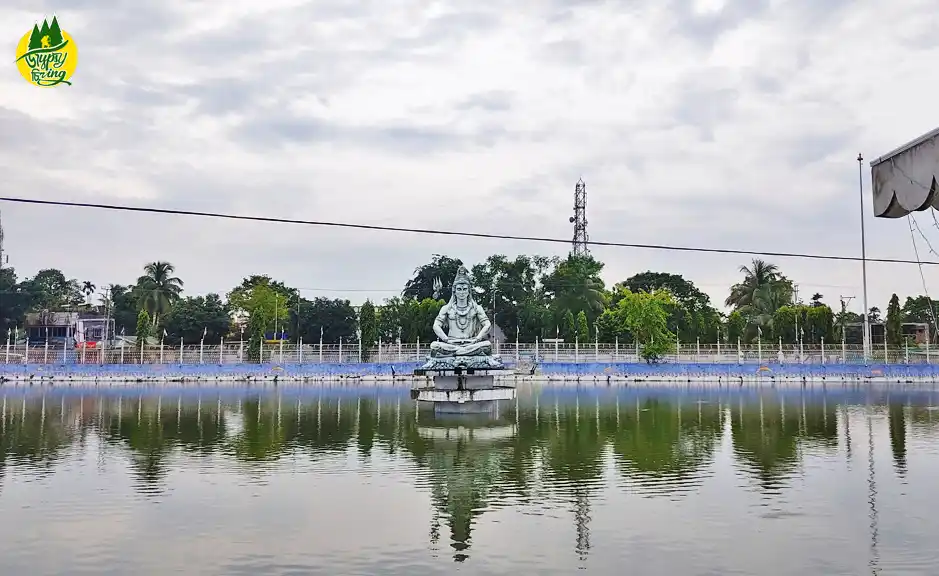
At the beginning of our journey, it started raining cats and dogs. We sure were disappointed but very adamant to visit Unakoti. It was a pleasant journey as we passed through tea gardens and beautiful landscapes.
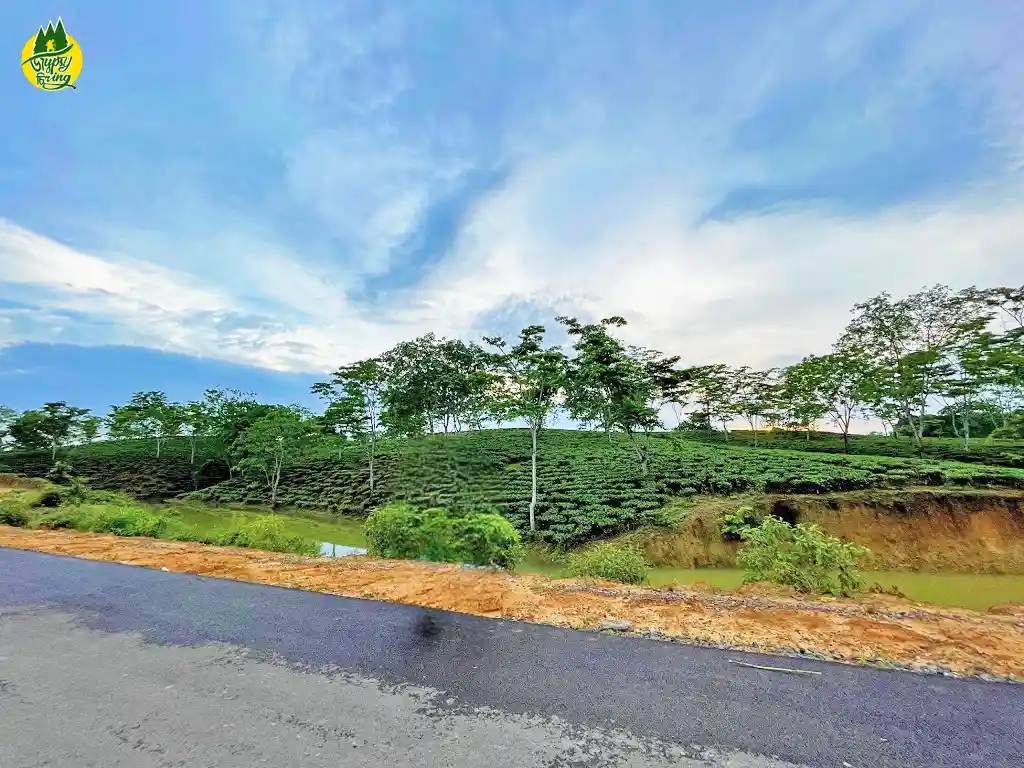
The rain continued even after we reached the Unakoti archaeological site. With no choice, we waited in the cab for about 30 minutes for the rain to stop.
Relieved and happy, we headed to the front of the huge entrance gate of the Unakoti Archaeological Site. Beside the gate was a registration counter where we declared our identities and belongings. Upon entering the area we followed the sign that said Unakoti Tirtha.
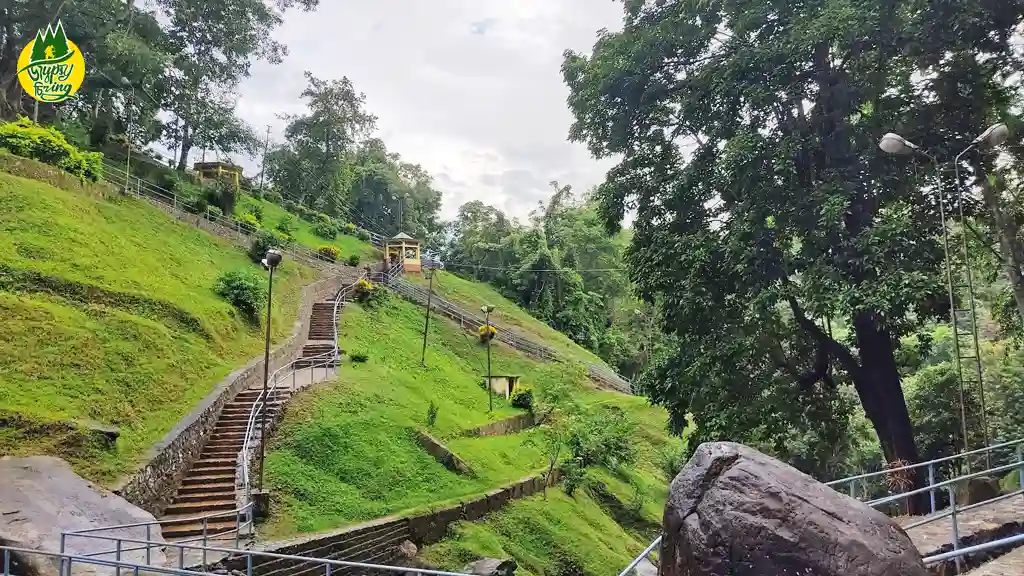
From the entrance and about 10 meters away, a series of steps leads down to the slope of the cliff and starting from the right to the frontal view, the marvellous rock cuttings and breathtaking sculptures embedded could be clearly spectated. It was as if the huge faces were smiling at us.
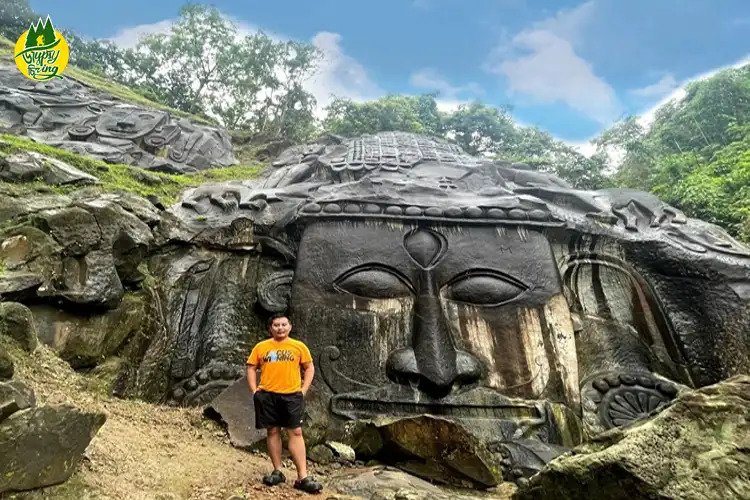
The first one had us totally amazed as we had not seen anything like this before. A few steps down below, there was another face, which was quite similar to the previous one and just beside that was a cascade waterfall running down from between the cracks of the rocks.
The trail bifurcated and we took the steps uphill which seems to be never-ending from down below besides a number of scattered boulders that have their own images. Further up, right where the steps end, there are images of two female figures on the stone.
The flight of stairs further down on the other side of the valley leads to some cliff faces with another waterfall flowing down.
View this post on Instagram A post shared by Sammy (@sammy_yaden_lushai)
On the cliff face is the huge structure of Ganesha along with a few other sculptures. In the monsoon, the waterfall flows over the rock carvings of Ganesha’s head, bathing the deity. The massive gallery of Unakoti also features numerous panels and rock carvings. The most famous one is perhaps the gigantic image of Lord Shiva.
Taking a deep breath and feeling the nature around me was magical. Raindrops refreshed the trees, turning them into a soothing, vibrant green spectacle that delighted the eyes. The gushing of waterfalls and the birds chirping added a peaceful ambience to the moment.
How to reach the Unakoti Archaeological Site?
I planned to go to Dharmanagar town by train from Agartala city which is about 22 km away. But unfortunately, due to heavy traffic, I could not reach the railway station on time i.e. 11:00 am.
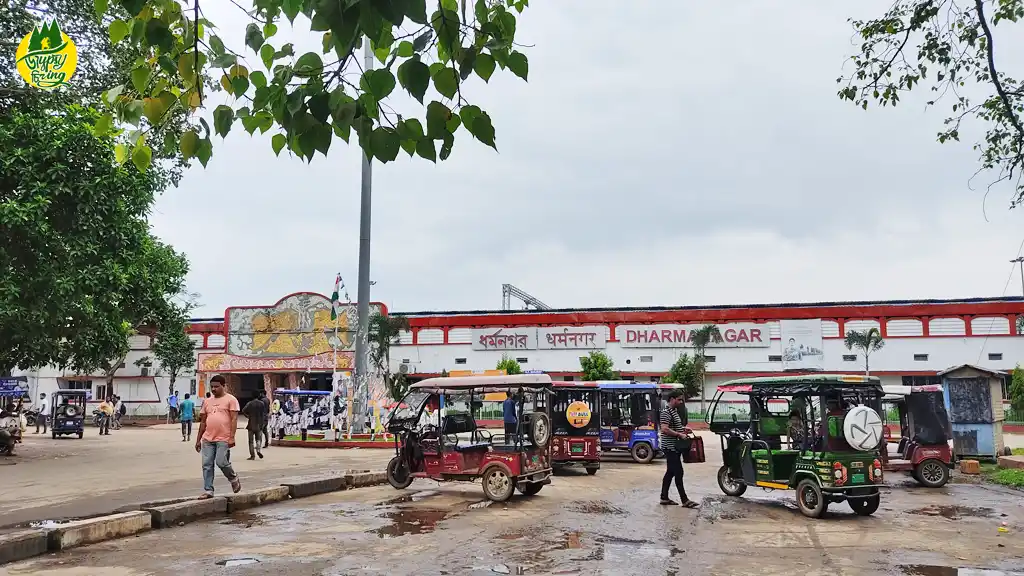
I had to come up with another means of transport which was taking a local bus. I headed towards ISBT to catch a bus leading to Dharmanagar as I was en route to another location again. So after a long 6 hours of journey by bus and which only takes 3-4 hours by train, I finally arrived at Dharmanagar.
After my third day of stay, we headed out from Dharmanagar ISBT, taking a hired cab that charged us around Rs 1400 (round trip) way up to the archaeological site.
However, several carpools are also available at a nominal cost of Rs 70/80 which stops at the highway junction leading to the Unakoti Archaeological Site , which is a few meters away and requires walking to reach the spot.
The nearest Agartala Airport is located about 178 km from Kailashahar town. The nearest railway station is at Kumarghat which is 26 km from Kailashahar.
Kailashahar is easily accessible through frequent bus services that link it with Guwahati, Shillong, and Silchar, as well as various districts and sub-divisional towns within the State.
Where to Stay in Unakoti?
Tourists can stay in a government tourist lodge (Unakoti Tourist Lodge) at Kailashahar approximately about 11 km from Unakoti Hills. The rates are quite reasonable starting from Rs 800.
There are also a number of hotels and guest houses at Dharmanagar as well like Hotel Sun and Hotel Unakuti.
What is the best time to visit Unakoti?
The Unakoti Heritage site can be visited all year round. To witness the cultural and religious essence of the place, you can visit Unakoti during festivals associated with Lord Shiva as well as the Ashokastami Festival or the Unakoti Festival.
Nestled amidst nature’s bounty, Unakoti Rock Carvings is a captivating blend of sacred allure and historical wonders. Adorned with magnificent rock-cut depictions of deities, this place truly embodies divinity carved into stone.
As you explore, you’ll find yourself in awe of the grandeur that nature and history have woven together here.
Don’t miss the enchanting ‘Sitakunda’ or ‘Ashtamikunda’, a natural spring-fed reservoir. When Maghi Sankranti (February) and Ashokastami arrive, brave souls plunge into its crystal-clear waters, defying the chilly embrace of winter.
Unakoti is more than a destination; it’s a spiritual and cultural journey waiting to be embraced.
The Unakoti Rock Carvings stand as a testament to the beauty and richness of Tripura’s cultural heritage and will be a place of photographers’ delight and a history buffs curiosity. A heritage of Tripura Tourism, Unakoti is a must-visit place.
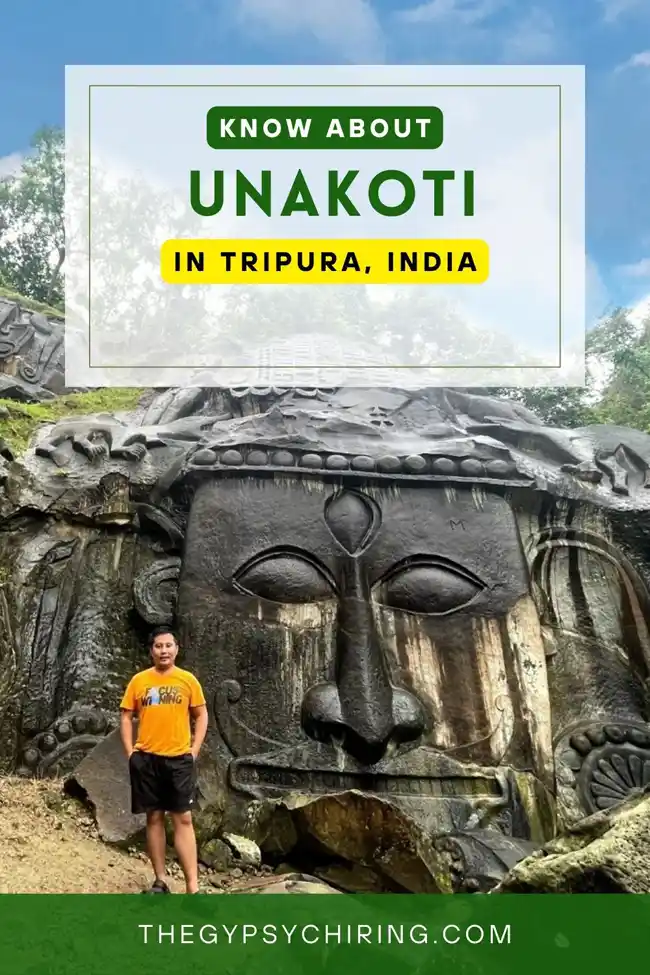
Found the article helpful? Share it with your friends or anyone who is planning to visit Unakoti.
Disclosure: The post contains links to trusted partners. Read our Affiliate Disclosure to know more.

You Might also Like:

ABOUT THE AUTHOR
2 thoughts on “India’s Ancient Unakoti Rock Carvings – Tripura Tourism”
Excellent. We are senior citizens from Chennai Tamil Nadu and we will be visiting Unakoti in October. Can you please tell me whether there are guides for hire .. one more thing. People tell us that toilet facilities are not good .. How did you all manage? Thanks in advance… Hariharan
Hi Hariharan,
About the tour guides, I am not sure whether there any guides for hire in Unakoti side. However, there are a few in Agartala. And yes, toilets are there on the spot and the condition should be improved.
Leave a Comment Cancel reply
Save my name and email in this browser for the next time I comment.
Let's Connect
Instagram feed.
Travel Tips
blogging tips
travel gears
Important Links
privacy policy
The site may contain affiliate links. Read our Affiliate Disclosure .
© 2024 The Gypsy Chiring. All rights reserved.
Unakoti Rock Carvings
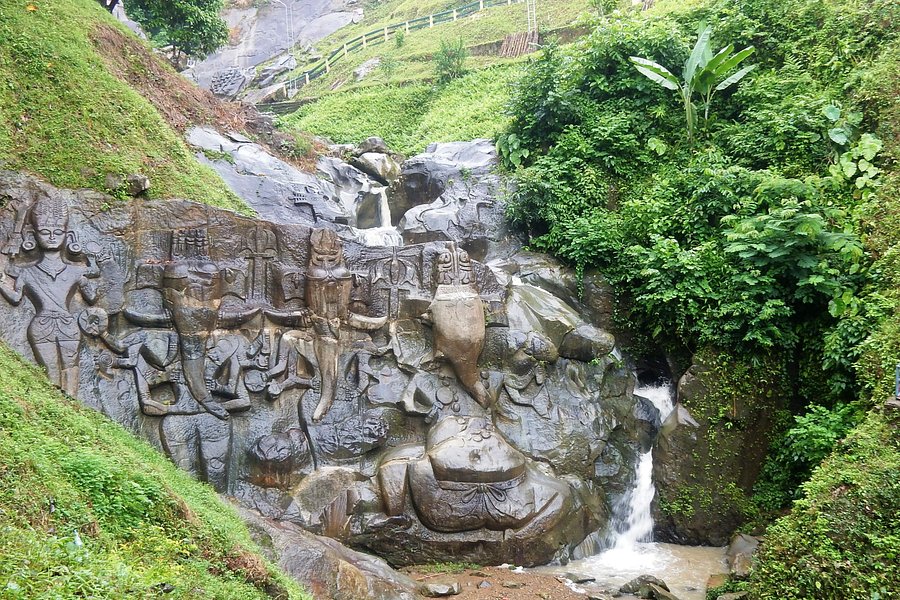
Top ways to experience nearby attractions

Most Recent: Reviews ordered by most recent publish date in descending order.
Detailed Reviews: Reviews ordered by recency and descriptiveness of user-identified themes such as waiting time, length of visit, general tips, and location information.
Also popular with travellers

Unakoti Rock Carvings - All You Need to Know BEFORE You Go (2024) - Tripadvisor
- Sun - Sat 8:00 AM - 5:00 PM
- (7.04 km) Unakoti Tourist Lodge
- (11.79 km) SPOT ON 63845 Hotel North Continental
- (12.43 km) Hotel J C Plaza
- (14.36 km) Juri Tourist Lodge
- (5.73 km) Circuit House
- (11.86 km) Donas Restaurant
- (0.79 km) Unakoti Food Hills
- (6.90 km) Snack Deck
- (6.99 km) Cakes & Buns Kailashahar
- (11.47 km) Raj Dhaba
Unakoti Rock Carvings

Top ways to experience nearby attractions

Most Recent: Reviews ordered by most recent publish date in descending order.
Detailed Reviews: Reviews ordered by recency and descriptiveness of user-identified themes such as wait time, length of visit, general tips, and location information.

Also popular with travelers

Unakoti Rock Carvings - All You Need to Know BEFORE You Go (2024)
- Sun - Sat 8:00 AM - 5:00 PM
- (4.40 mi) Unakoti Tourist Lodge
- (7.37 mi) SPOT ON 63845 Hotel North Continental
- (7.77 mi) Hotel J C Plaza
- (8.98 mi) Juri Tourist Lodge
- (3.58 mi) Circuit House
- (7.41 mi) Donas Restaurant
- (0.49 mi) Unakoti Food Hills
- (4.31 mi) Snack Deck
- (4.37 mi) Cakes & Buns Kailashahar
- (7.17 mi) Raj Dhaba
Tripura: The Perfect 7-day Itinerary
Tripura is undoubtedly one of the most fascinating states of India. Located in north-eastern India, it was called Kirata Desh or land of the Kirata in Mahabharata. The origin of the name Tripura is often linked with the Goddess Tripura Sundari, one of the state’s most esteemed deities. But, in all probability, the name ‘Tripura’ originates from ‘Tipra’, ‘Tippera’, and ‘Tuipura’, which denote the state’s indigenous population.
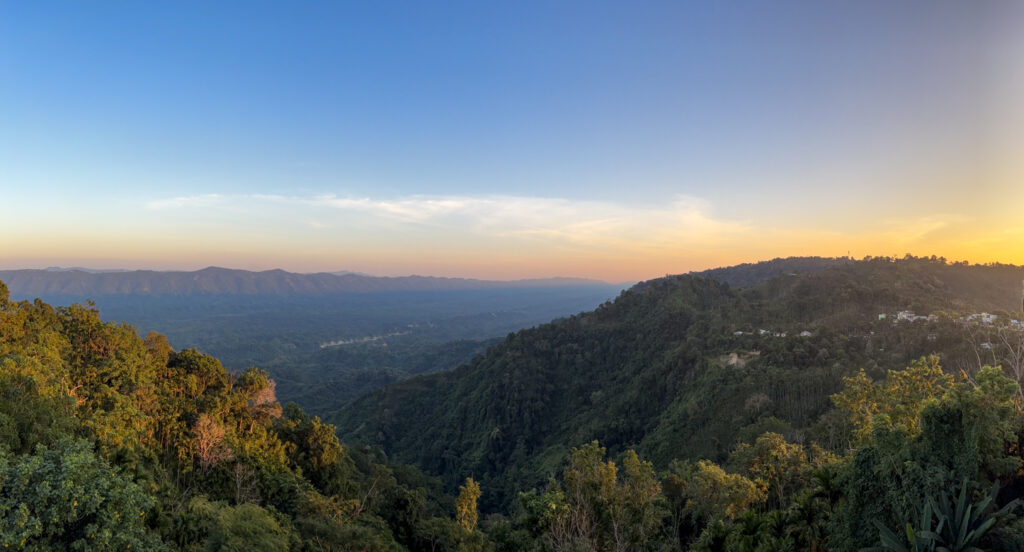
Like the other northeastern states of India, Tripura has a sizeable tribal population. There are 19 tribes residing here, thus making Tripura a culturally rich and diverse state. Tripura also boasts unique archaeological sites, such as Unakoti, Chabimura, and the Buddhist site of Pilak. In addition, the natural beauty of Tripura is exceptional, thanks to the Jampui Hills, Gomati River, and an array of pristine lakes.

We covered the entire Tripura (except Pilak) within 7 days. Here goes our 7-day itinerary for travelling to this gem of the north-east.

Table of Contents
Day 1: Reaching Agartala and exploring the capital:
The flight from Kolkata takes less than an hour to reach Agartala, Tripura’s capital city. At first glance, Agartala resembled a nondescript town in north Bengal. With locals conversing mostly in Bengali and the shop hoardings’ being displayed in Bengali, it did not feel like we had just arrived in a completely new state.
We checked in at Hotel Tripura Sundari, which lies just beside the Agartala rail station. Since we had an early morning train to catch, we decided to stay near the rail station instead of the main city area. The hotel is a basic one, although the rooms are spacious, clean, and provided with all amenities. The price of double rooms is INR 1100, while single rooms are INR 800. You need to bargain a bit to get a lower price.
Afterwards, we swiftly showered, got dressed, grabbed a quick lunch at the nearby Sanskar Restaurant (the food is absolutely lip-smacking here), and set out to explore Agartala. For venturing within Agartala, e-rickshaws and autos are the best options. We hired an e-rickshaw for INR 500 for the entire day.
1. Ujjayanta Palace:
We first visited the splendid Ujjayanta Palace. The pristine Palace was built by Maharaja Radha Kishore Manikya in 1901 and named by Nobel laureate Rabindranath Tagore. Situated at the heart of Agartala, it was designed by Sir Alexander Martin in a Neo-classical style. The architectural style is influenced by Roman, Mughal, and British styles.

The Ujjayanta Palace used to be the residence of the royal family of Tripura. Covering an area of around 250 acres, the palace has a throne room, durbar hall, library, and other rooms. Later, after independence, the palace served as the State Legislative Assembly until 2011. At present, the Ujjayanta Palace has been converted into a vast museum, which showcases the history, geography, heritage, and culture of Tripura.

Things to remember while visiting Ujjayanta Palace:
- The palace remains open from 10-15 AM to 5-15 PM.
- It remains closed on Mondays and Govt. holidays.
- The entry fee for domestic tourists is INR 40 per person, INR 100 for Bangladeshi tourists, and INR 250 for foreign tourists.
- Entry is free for children below 10 years and school students on excursion trips with uniforms.
- Professional still camera charge is INR 600 per camera and INR 1500 for professional video cameras.
- Light and sound show is also held here daily. There are two shows – the first from 6-30 PM to 7 PM, and the second one from 7-30 PM to 8 PM. The entry fee for adults is INR 100 and for children below 10 years is INR 50.
Pro tip – Try visiting after 3 PM, as the palace looks spectacular under the afternoon sun.
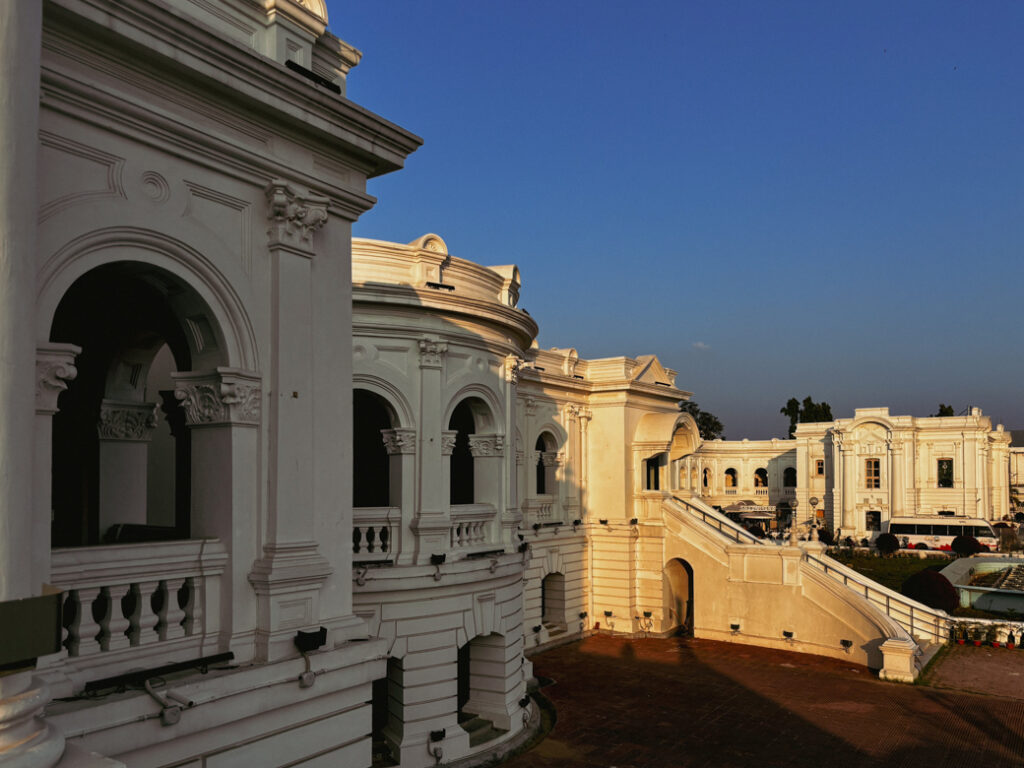
2. Lakshmi Narayan Temple:
This beautiful temple was built by Maharaja Birendra Kishore Manikya. Dedicated to Narayan and Lakshmi, it lies in the Ujjayanta Palace premises. Sadly, the temple was closed when we visited.
3. Durga Bari:
Located just beside the Ujjayanta Palace, the temple is consecrated to Goddess Durga. The Durga Puja is celebrated with huge fanfare here. Interestingly, the Goddess here has two hands instead of her usual ten hands.

4. Jagannath Bari:
This temple was built by Maharaja Radha Kishore Manikya in the 19 th century. The temple is now managed by Sri Chaitanya Goudiya Math. Here, Lord Jagannatha is worshipped along with his siblings, Balabhadra and Subhadra. The entrance of the temple is modelled after the ‘Ratha’ or chariot of Jagannatha. The temple premise has beautiful idols of Sri Krishna, Sri Rama, Lakshmi – Narayan, Siva -Parvati, and Sri Chaitanya Mahaprabhu.

The Jagannath Bari also offers accommodation to pilgrims and tourists. You can contact them at 0381 – 2324497/9774034517.
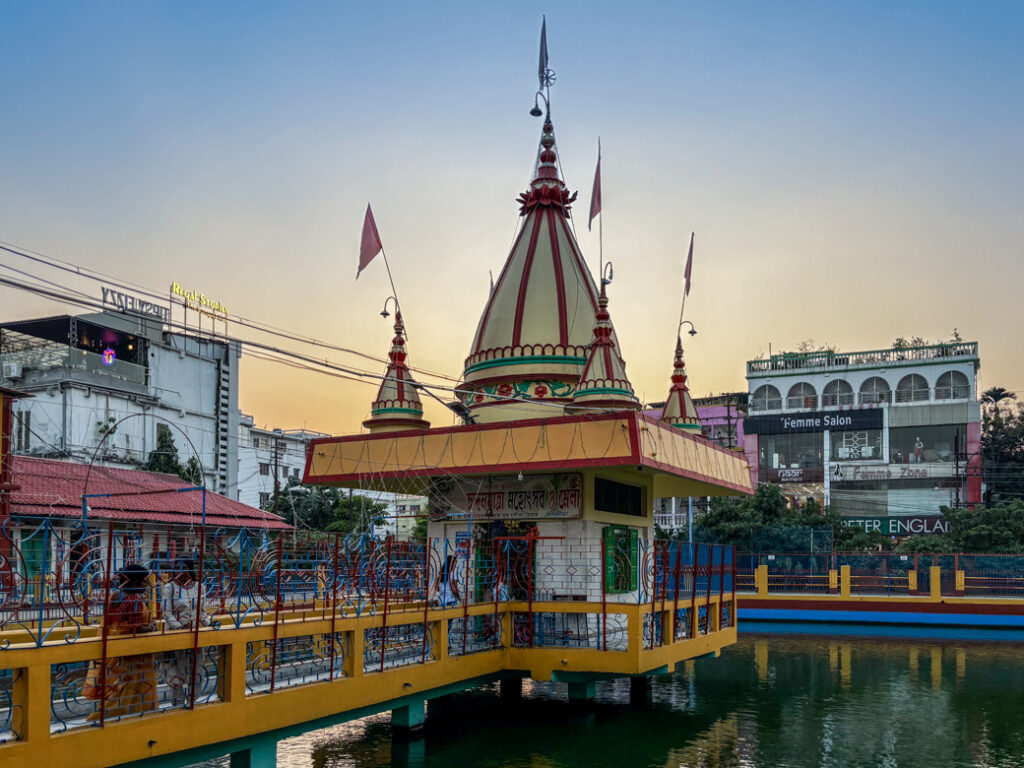
Later, we explored the roadside food joints near Ujjayanta Palace. Countless food stalls start operating here after 5 PM. You can find chats and panipuris, momo and soups, rolls and chowmein, chop and beguni, as well as Tripuri delicacies such as Tohan Mosdeng and Wahan Mosdeng. The place looks like a small fair during the evening.
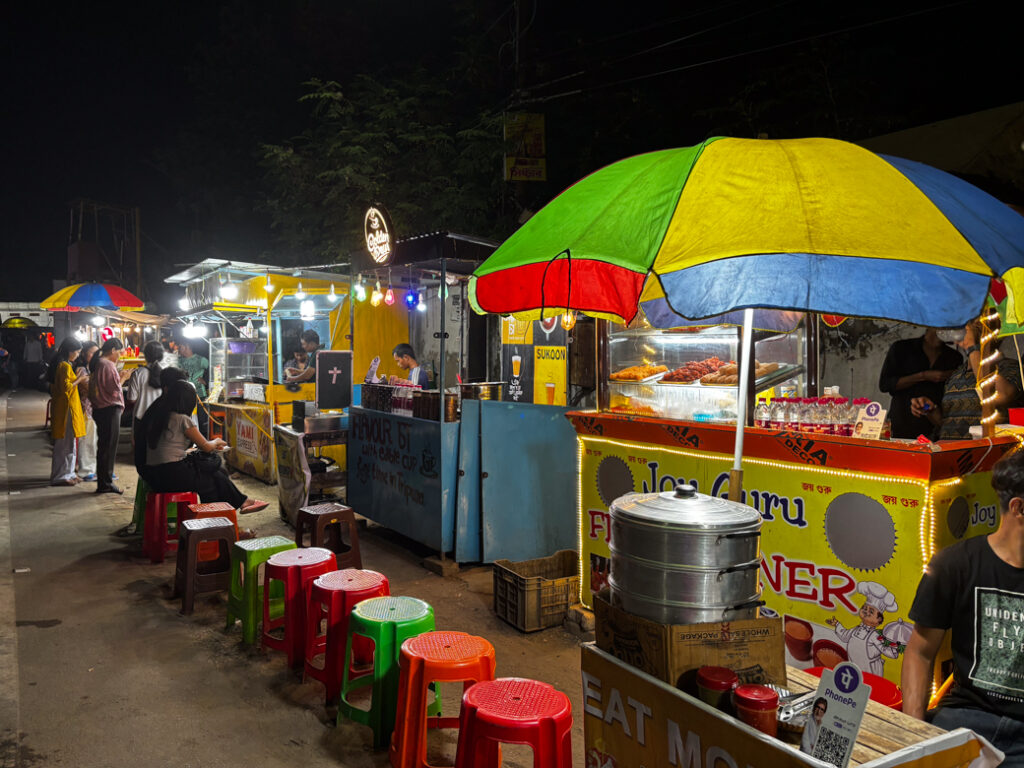
Day 2: Exploring a temple, a zoo, and a border check post:
1. kasba kali temple, kamala sagar:.
The second day being the Kali Puja and Diwali, we started by paying a visit to the revered Kasba Kali Temple. Situated just beside the international border of Bangladesh, this temple was built by Maharaja Dhana Manikya in the 15 th century. He also commissioned the digging of the picturesque Kamala Sagar just beside the temple premises.

Though the idol is worshipped as Kasbeshwari Kali, it actually depicts the ten-handed Durga slaying the buffalo demon, Mahisasura. Surprisingly, the base platform has an image of Siva.

The temple has a serene atmosphere, and the darshan and Puja offerings go here smoothly.
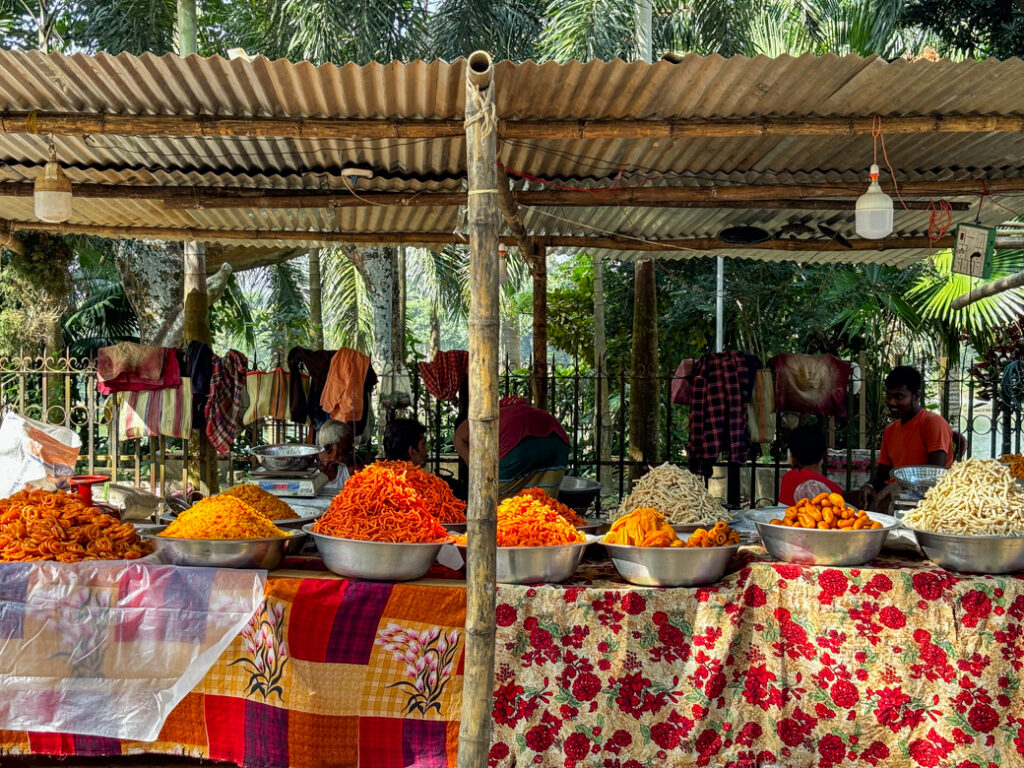
2. Sepahijala Wildlife Sanctuary and Zoological Park:
Afterwards, we went to the Sepahijala Wildlife Sanctuary and Zoological Park. It is, undoubtedly, one of the most popular tourist attractions of Tripura. Covering an area of 19 km, it is famous for being the home of Clouded Leopard, Spectacled Monkey, and Hoolock Gibbon. It is also the habitat of over 150 varieties of migratory birds.
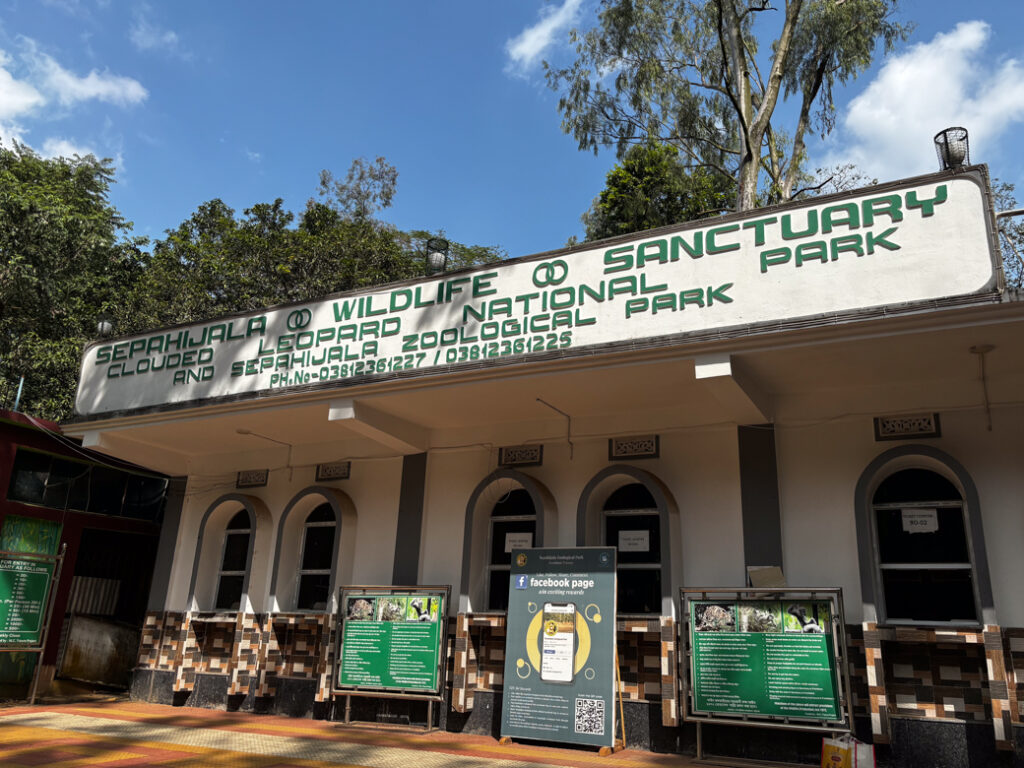
Things to remember while visiting the Sepahijala Sanctuary:
- The Sepahijala Wildlife Sanctuary remains open from 8 AM to 4 PM every day, except Friday.
- The entry fee for adults is INR 20 and for children below the age of 18 INR 10.
- Vehicles are allowed inside the sanctuary up to the gate of the Zoological Park. Entry fee for light vehicles is INR 50, auto INR 30, and bike/scooter INR 20.
- Still camera charge is INR 20, while the video camera is INR 2000.
- Tickets for entering the Zoological Park need to be purchased separately.
- Exploring the Zoological Park requires lots of walking. So, we advise wearing comfortable shoes and carrying drinking water and an umbrella.
- Toilet facilities are available at various points inside the Zoological Park.
3. Akhahura Integrated Check Post:
One of the top attractions of Tripura is the Akhahura Integrated Check Post. It was inaugurated back in 2013 and serves as the second-largest Indian trading centre with Bangladesh. Like the Wagah border in Amritsar, Akhahura also holds the ceremony of lowering the flags of the two countries by security personnel with a synchronised performance of the two sides.

It was really fascinating to watch the parades and lowering of the national flag by the security forces. Also, since it was Diwali, sweets and greetings were exchanged between the two countries. The visitors also participated in the Diwali celebrations along with the soldiers.
Things to remember while visiting the Akhahura Check Post:
- Visitors are allowed only on Saturdays and Sundays.
- The program starts at 5 PM.
- Reach the spot by 4 PM so that you can get a seat with an unobstructed view.
- You need to deposit your recognized identity cards before proceeding to the border. Also, you have to undergo body frisking as well for security reasons.
Day 3: Journey to Jampui Hills:
We started our third day by catching the early morning Jan Shatabdi Express for Dharmapur, which is the nearest rail station to Vanghmun in Jampui Hills. From Dharmanagar, we hired a cab for INR 2000 to reach Vanghmun. The road to Vanghmun is excellent, and it took us 2 hours to reach the popular hill station of Tripura.
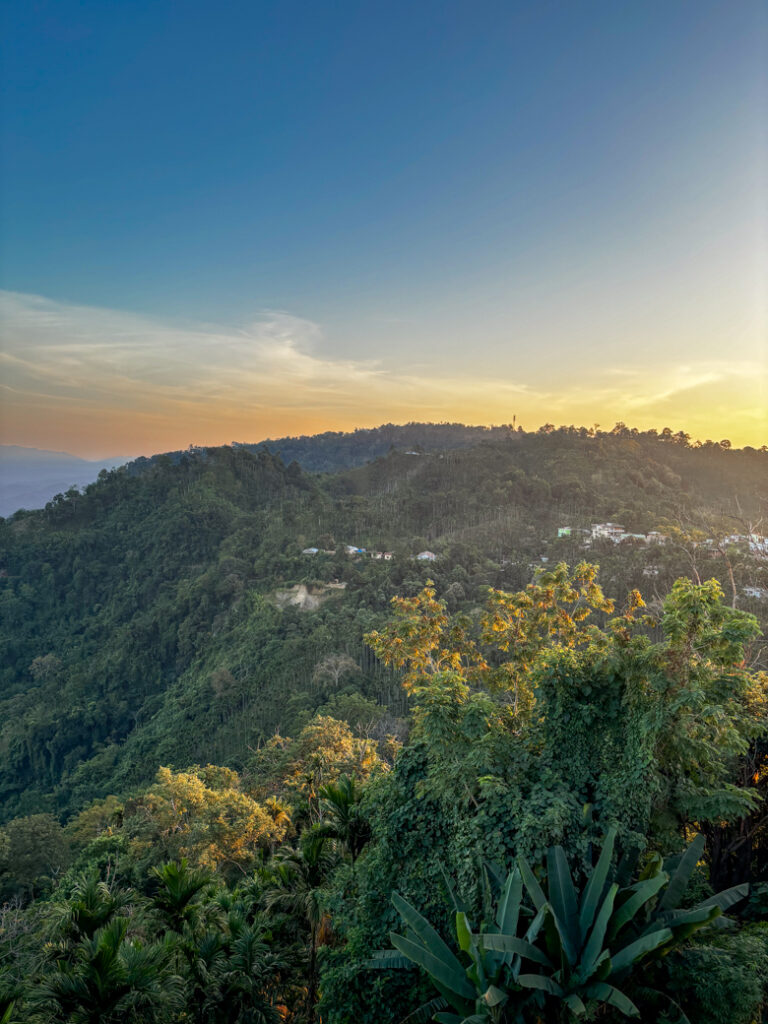
We checked in at Eden Tourist Lodge of Tripura Tourism . This is the only reliable option for accommodation in Jampui. We had booked a big 3-bedroom room for INR 1900 per night. Food is available in the lodge and you have to book your meal beforehand. The quality of food is dismal here. Too bad, there is no other option of dining in the vicinity.
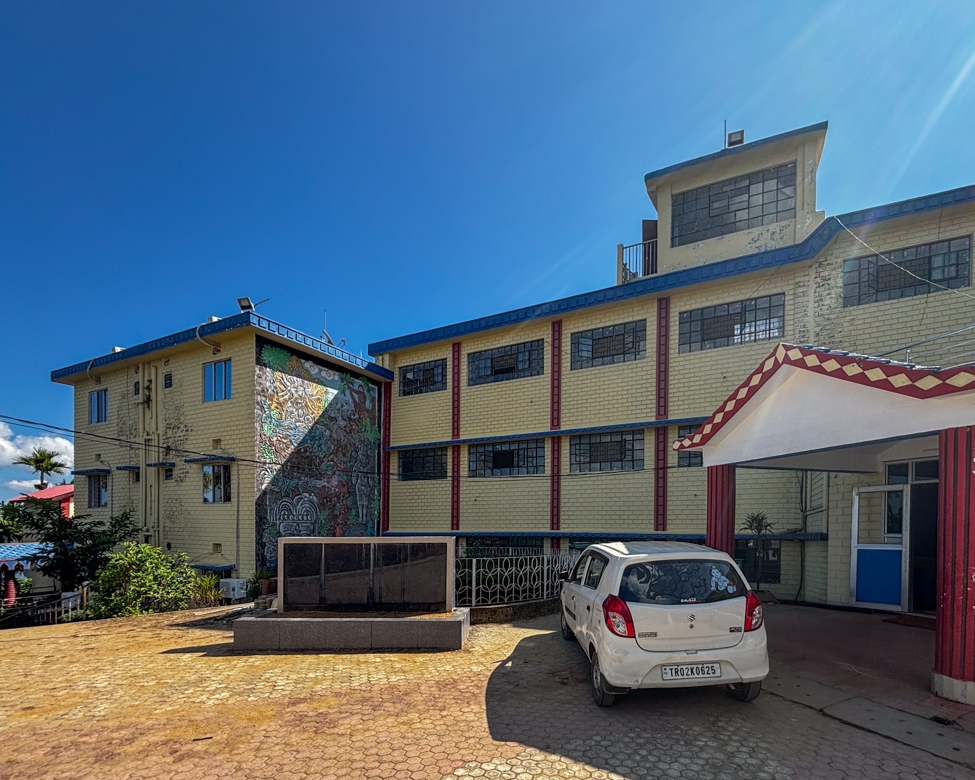
The Jampui Hills is a part of the Lushai Hills. Located in the North Tripura district, it comprises of 10 small villages of which Vanghmun is the headquarters. Known for its lush nature, orange orchards, and orchid bloom, Jampui Hills is a must-visit in Tripura. It is also renowned for amazing sunrise and sunset views.

Since the Eden Tourist Lodge has sunrise and sunset points inside the premises, we did not venture out. Both the sunrise and sunset were phenomenal.
Day 4: Ruins of Unakoti:
The next day, we left Vanghmun right after sunrise. Our destination was Unakoti , the enigmatic Saiva pilgrimage centre. Unakoti has been on our bucket list for a long time, and we finally managed to visit it. Previously, the road leading to Unakoti was nothing short of a nightmare. However, the scenario has drastically changed now, and the road has been repaired and widened.
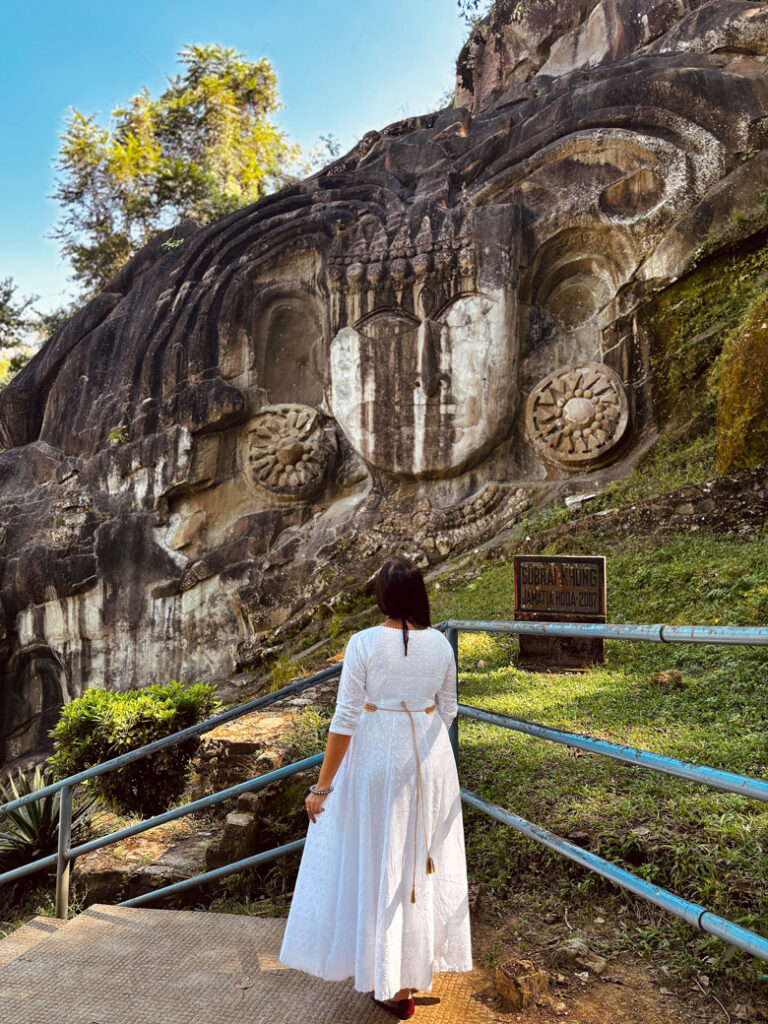
In Bengali, ‘Unakoti’ literally translates to ‘one less than a crore’. In the local Kokborok language, it is called ‘Subrai Khung’. The myth of Unakoti centres around Siva and his infamous rage. According to the legend, it was the meeting place of the 99,99,999 Gods and Goddesses along with Siva. The entourage decided to take a rest and spent one night here.
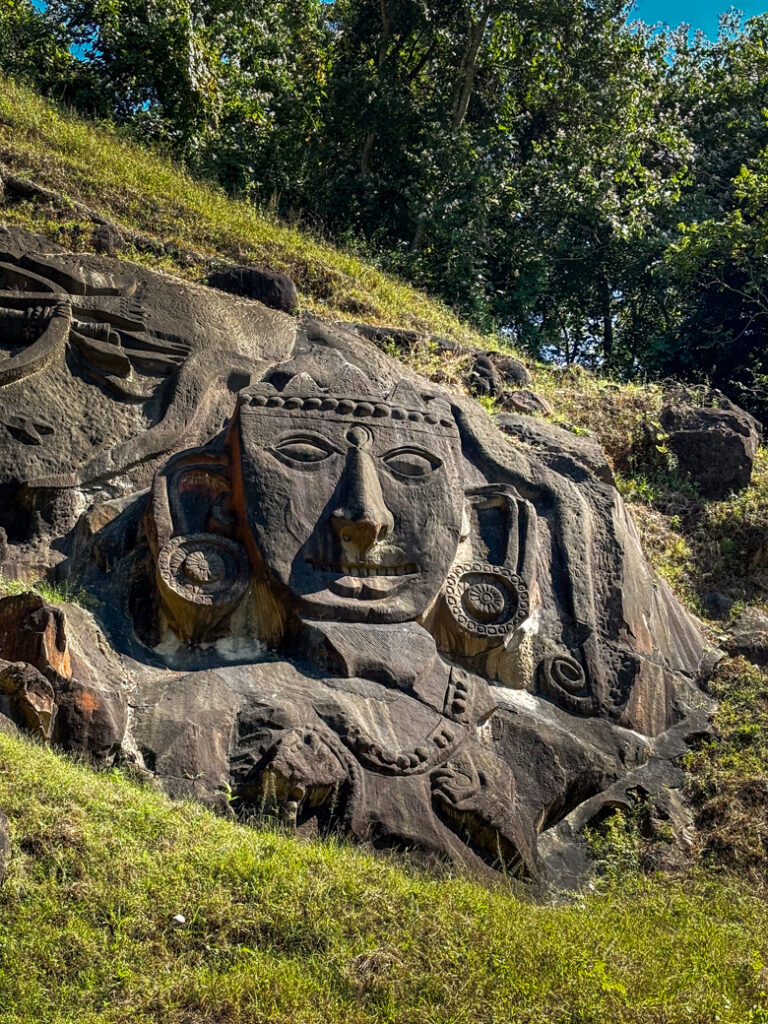
In turn, Siva explicitly directed them to wake up before dawn to resume their journey. However, only Siva was awake before sunrise while the rest of the retinue slept. Enraged by this disregard, Siva unleashed his fury, cursed them all to stone, and went on his way to Kashi alone. Thus, Unakoti became the abode of one less than a crore divine figures.

Unakoti is characterized by both colossal bas reliefs as also loose sculptures of various sizes. The most notable ones are Gangadhara Siva, Unakotisvara Kal Bhairava, Durga, Ganga, Siva – Parvati as Kirata – Kirati, Ganesha, and so on.

Things to remember while visiting Unakoti:
- No tickets are required for Unakoti. You just have to enrol your name and a few details in a register at the gate.
- Try visiting before noon, as exploring the ruins becomes difficult under the harsh sun.
- Wear comfortable shoes, as visiting Unakoti involves climbing countless steep stairs.
- Apart from two shacks selling green coconuts, packaged mineral water, soft drinks, chips, cakes, and biscuits, you will find no restaurants here.
- A toilet facility, baby care room, and mobile phone charging points are available here.
- Unakoti itself does not have hotels. You need to stay either at Kailashahar or Dharmanagar. At Kailashahar, the only feasible option is Tripura Tourism’s Unakoti Tourist Lodge . By contrast, Dharmanagar offers more choices of accommodation, such as Lokenath Guest House, Hotel J C Plaza, Hotel Panchabati, and Hotel Unakoti.

After we completed exploring Unakoti, we returned to Dharmanagar and boarded the Agartala Express at 1 PM. We reached Agartala at 4 PM and spent our night there.
Day 5: Neer Mahal and the temples of Udaipur:
1. neer mahal:.
Our 5 th day in Tripura was a bright sunny morning, perfect for visiting the resplendent Neer Mahal . Neer Mahal is one of the two water palaces found in India, the other being the Jal Mahal of Jaipur, Rajasthan. Though Rajasthan’s water palace is one of the top attractions of India and thousands of visitors throng every day to catch a glimpse of the Jal Mahal, Tripura’s Neer Mahal is the larger of the two.
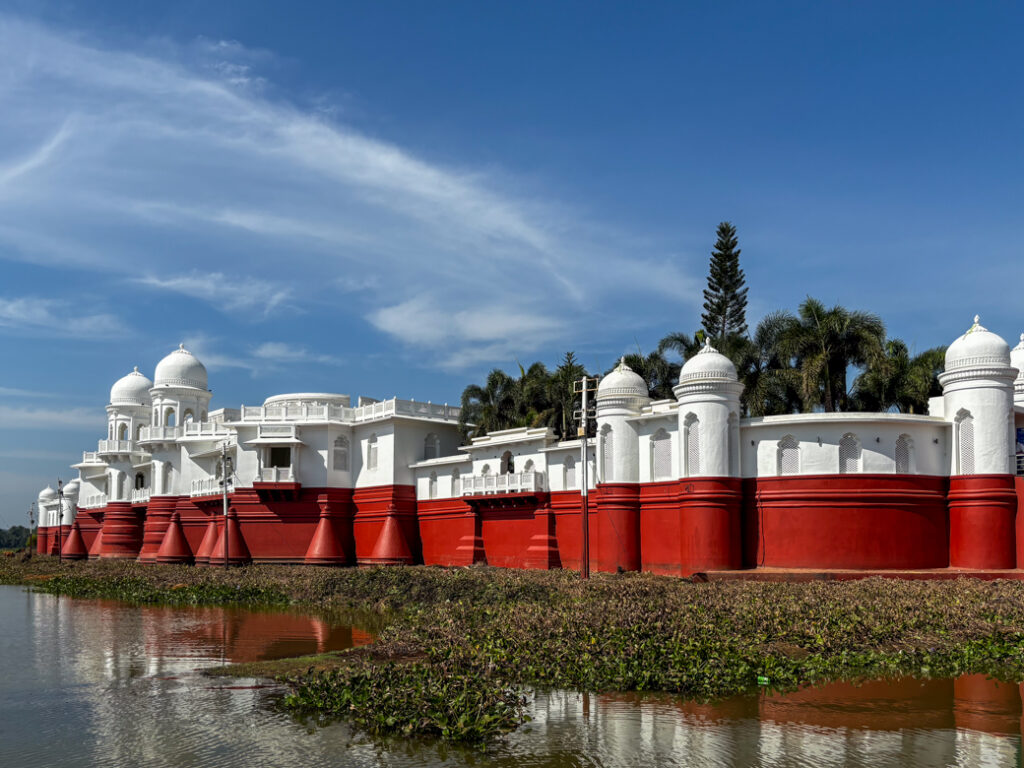
Neer Mahal translates to ‘water palace’. It was the brainchild of Maharaja Bir Bikram Kishore Manikya Debbarma, one of the most famous kings of Tripura. The Maharaja used Neer Mahal as a summer residence and a pleasure palace. Built amid the Rudra Sagar Lake, it was named ‘Neer Mahal’ by Nobel laureate Rabindranath Tagore.

Things to remember while visiting Neer Mahal:
- Since the Neer Mahal is situated right in the middle of a lake, you need to take a boat ride to reach the palace.
- The ticket counter for boats opens at 9 AM and closes at 5 in the evening.
- The regular boat fare per head is INR 50. Around 20 people are taken on a motorized boat.
- You can book a country boat for a maximum of 7 persons at INR 350.
- You can also reserve a special boat at INR 2500.
- The boat will take you to the gate of Neer Mahal. You will get 40 minutes to explore the palace. On the boat’s signal, you need to return ASAP.
- You will need to pay a parking charge of INR 50 near the boating ticket counter in case you are visiting by car or bike. After reaching the palace by boat, you have to pay INR 80 per head as the entrance fee.
- There are two options for accommodation here. First, you can stay at Sagar Mahal Tourist Lodge of Tripura Tourism. Secondly, you can opt for Polo Lake Resort.
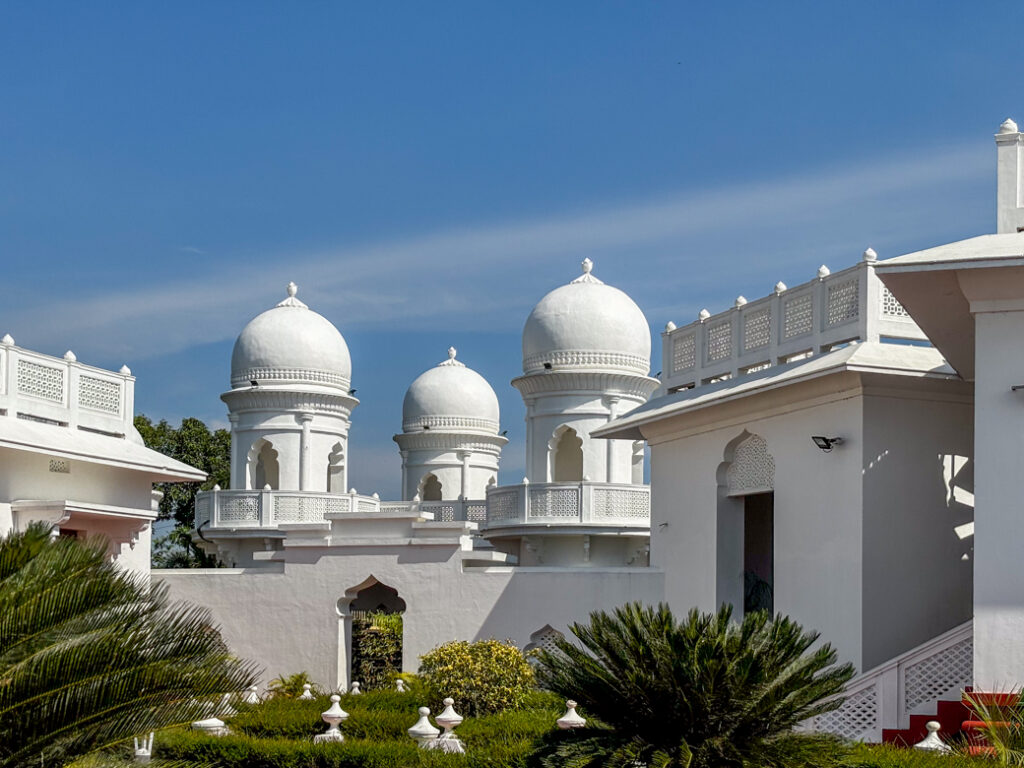
2. Temples of Udaipur:
Post lunch, we set out for the temples of Udaipur. First, we visited the Gunavati Group of Temples, located inside a dingy and busy lane of Udaipur. Three brick temples lie next to each other inside the premises. They were commissioned by Queen Gunavati, wife of Maharaja Govinda Manikya. The temples were built for the worship of Lord Vishnu. These temples somewhat resemble the ‘Chala’ type of temples found in West Bengal.

Next, we went to the Bhubaneshwari Temple, which has been immortalised by Rabindranath Tagore in his drama ‘Bisarjan’ and novel ‘Rajarshi’. Dedicated to Goddess Bhubaneshwari, it was built by Maharaja Govinda Manikya. It is constructed in the ‘Char Chala’ style of Bengal.

Lastly, we saw the Mahadev Temple or Mahadev Bari, which is revered as the home of Tripuresh Bhairava. This temple was commissioned by Maharaja Dhanya Manikya and built similarly to that of the Bhubaneshwari Temple.
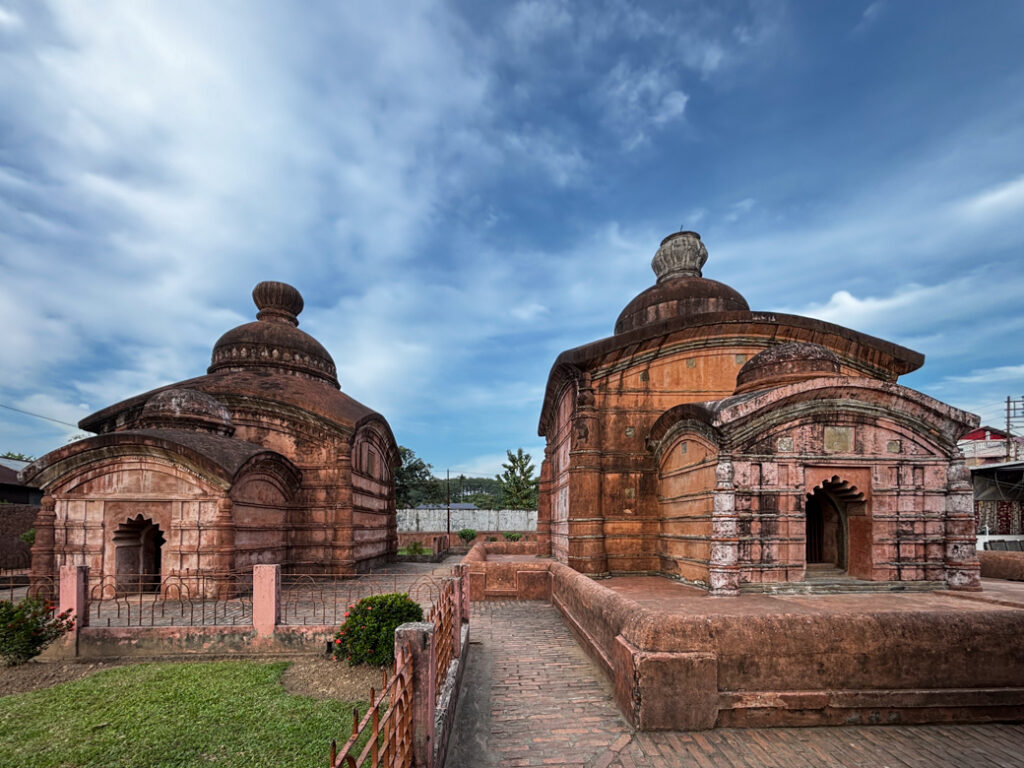
For the night, we stayed at Tripura Tourism’s Gunavati Yatri Niwas , which is situated just a stone’s throw away from the Tripura Sundari Temple. We had booked two rooms, each at INR 1500 each. The rooms were okay-ish. The hotel has a restaurant; however, the food is best to be avoided.
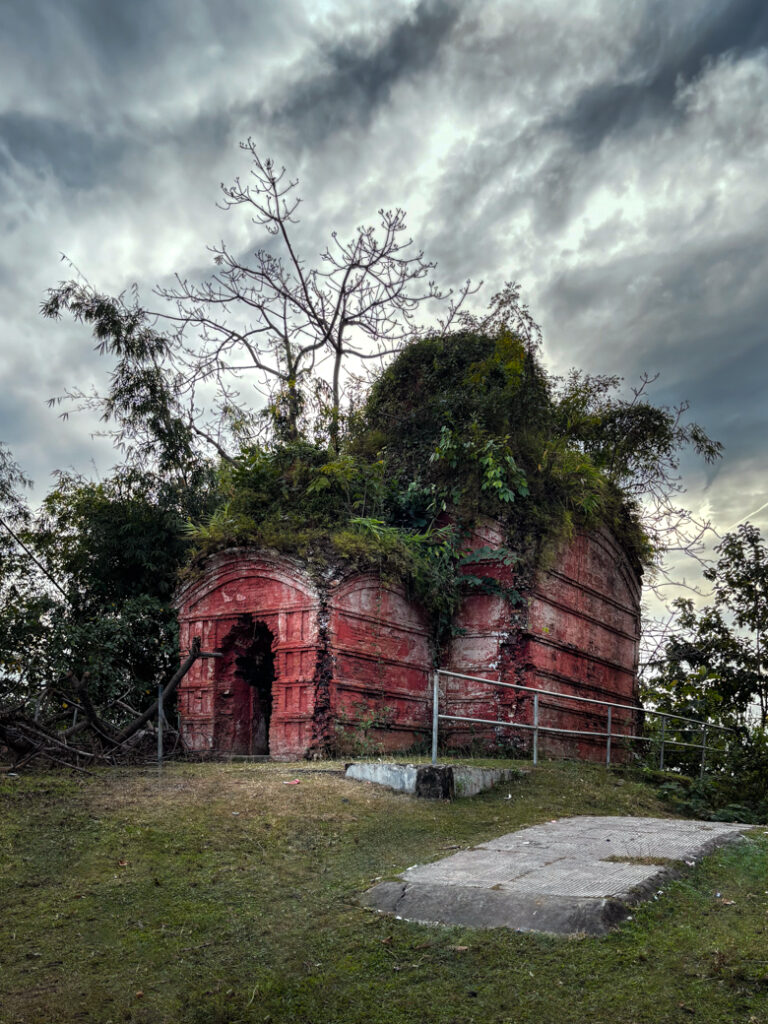
Day 6: Dumboor Lake and Chabimura:
We started our 6 th day early as Dumboor Lake is quite far from Matabari. The lake is located 85 km from Matabari, and it takes around 3 hours to cover the distance. Also, the weather forecast was not favourable, and rain was on the cards. Hence, an early head-start to the day.
En route, we went to Tirthamukh, the awe-inspiring source of the Gomati River. Then, we hired a boat at INR 2000 to explore the Dumboor Lake and Visit the Narkel Kunja island. This huge lake has been created by the confluence of the Raima and Saima Rivers. It expands over a massive area of 41 sq. km. It resembles the shape of Siva’s Damru, and hence the name ‘Dumboor’ has been provided for this lake.
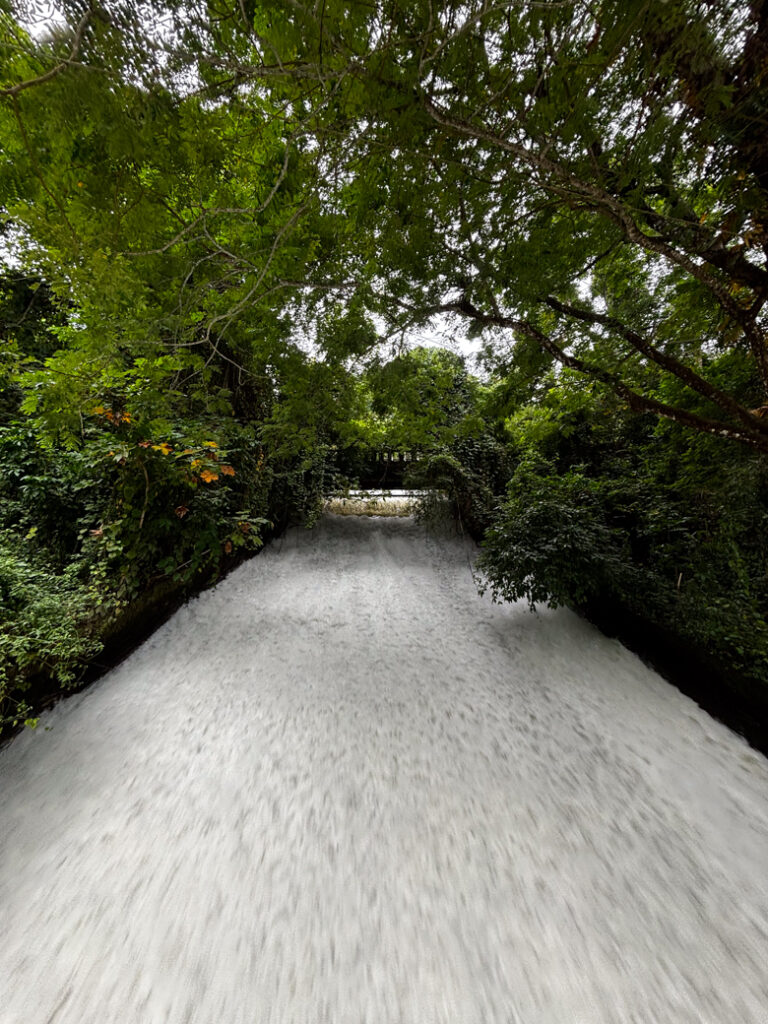
The boat ride to Narkel Kunja takes about 45 minutes. On this pleasant boat ride, we enjoyed the small villages lying on small islands and nature altogether.

The Narkel Kunja Island has been developed by Tripura Tourism. Cottages have been built along with a restaurant. As we explored the island on foot, we munched on fried freshly caught fish and shrimps as well as Hog Plum or ‘Aamra’.
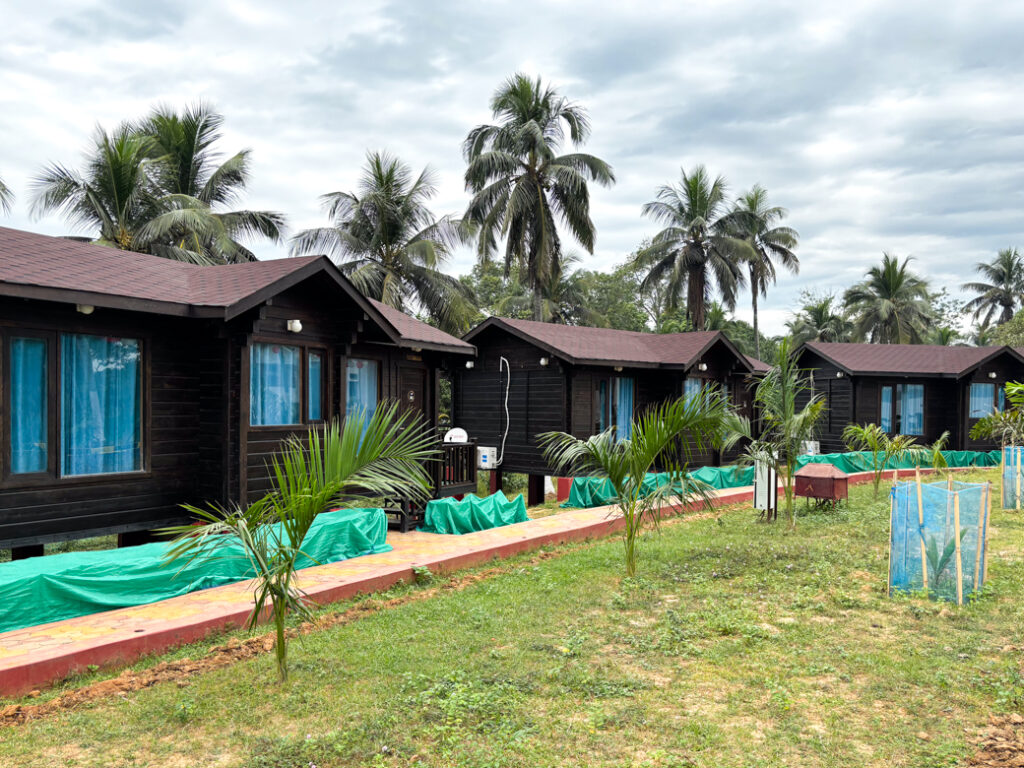
As the weather was taking a worse turn, we skipped lunch and headed straight towards Chabimura . Chabimura is home to a series of extraordinary rock-cut carvings of Hindu divinities, engraved on the hills that line the banks of the Gomati River. The word ‘Chabimura’ literally translates to ‘hill of pictures’ (in local dialect, ‘Mura’ means hill). This place is also called Devatamura or ‘hill of gods’. Chabimura is replete with panels of rock-cut sculptures on the steep slopes of the hills. The most stunning carvings belong to Mahisasuramardini, known locally as Chakrak Ma.
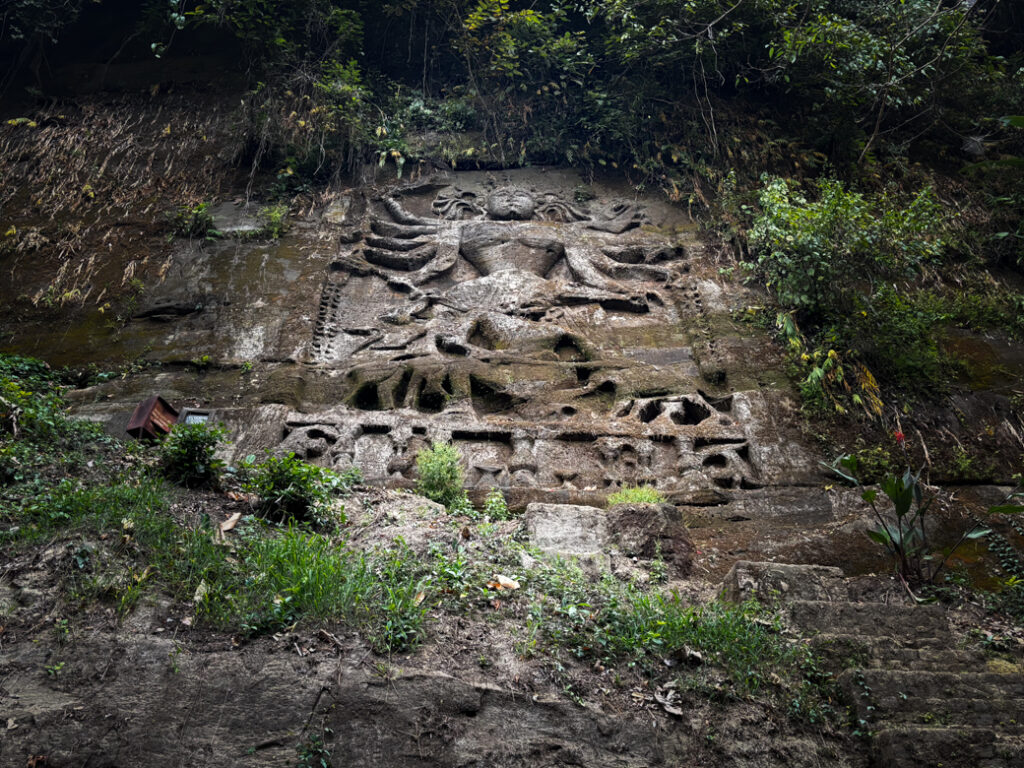
Things to remember while visiting Chabimura:
- Motor boats are the only option for braving the Gomati River in Chabimura. Boat rides are available till 4 PM.
- The ride costs INR 150 per head. The boats don’t leave until all the seats are booked. Generally, 10-15 passengers are accommodated in one motor boat.
- You can also hire an entire boat for yourself. This will cost you INR 3000.
- There are no hotels for spending the night at Chabimura. You can book a stay at Sagarika Parjatan Niwas near the Fatik Sagar Lake in Amarpur.

Day 7: Darsan of Tripura Sundari:
Our last day at Tripura started with an incessant cyclonic rainfall. A gale accompanied the heavy rainfall, and it seemed impossible to go out. We had initially planned to visit the Tripura Sundari Temple at 5 AM. However, our plan got delayed owing to the non-stop rain. At around 7, the rain slowed down a bit. Armed with umbrellas, we braved the rain as well as the strong wind. The road leading to the temple was flooded, and there was hardly any soul out.
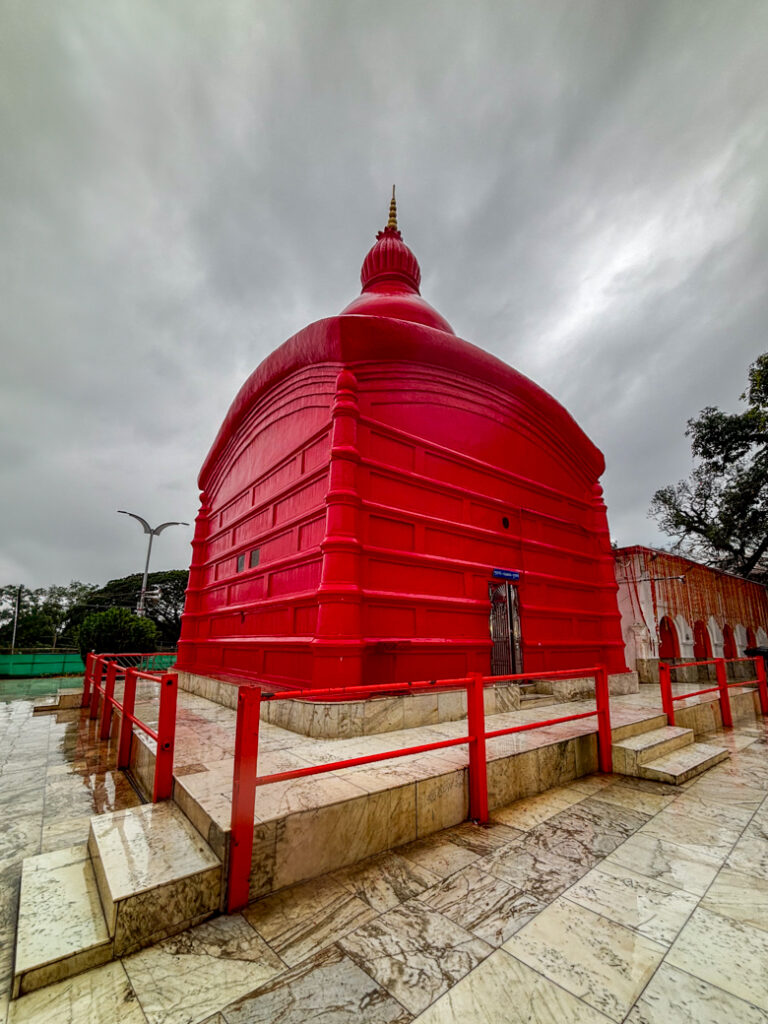
The temple, which usually bustles with throngs of pilgrims, was forlorn. We were the sole visitors. Consequently, we had an undeterred darshan of Goddess Tripura Sundari and offered Puja at ease. Pertinent to mention here that, Tripura Sundari Temple is one of the 51 Shakti Peethas and Sati’s right foot had fallen here. Hence, this temple is regarded as one of the holiest temples not only in Tripura but also in India.

Things to remember while visiting Tripura Sundari Temple:
- The temple opens at 4 AM and closes at 10 PM.
- The temple remains closed for an hour after the Goddess is served ‘Anna Bhoga’ at 1-30 PM.
- Try visiting as early as possible.
- Try avoiding a visit to the temple during the Kali Puja, as countless people visit Mata Bari during this festival.
- The ‘pera’ of Tripura Sundari Temple is delicious. There are numerous ‘pera’ shops lining the vicinity of the temple.

Important FAQs:
1. how can i reach tripura.
By train: You can catch 02501 Kolkata – Agartala Special Express from Kolkata station and 13173 Kanchanjangha Express from Sealdah station. The journey takes around 32 hours to complete.
By air: Multiple flights fly to Agartala from Kolkata daily. It takes less than an hour to travel by air.
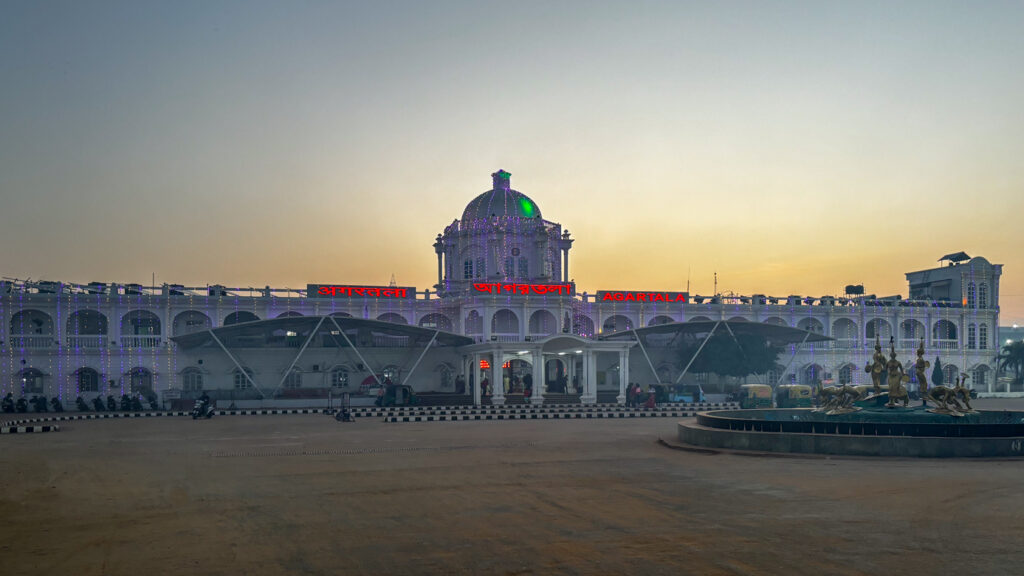
2. How can I travel inside Tripura?
Tripura itself has great rail connectivity. You can avail trains to travel to important places such as Udaipur, Dharmanagar, and Kailashahar.
3. Where can I stay in Tripura?
At Agartala: Hotel Tripura Sundari, Hotel Sonar Tori, and Hotel Polo Towers.
At Vanghmun, Jampui Hills: Eden Tourist Lodge.
At Dharmanagar: Lokenath Guest House, Hotel JC Palace, Hotel Panchabati.
At Unakoti: Unakoti Tourist Lodge, Kailashahar.
At Udaipur: Gunavati Yatri Niwas, Mata Bari.
At Neer Mahal: Sagar Mahal Tourist Lodge and Polo Lake Resort.
At Amarpur: Sagarika Paryatan Niwas.
At Dumboor Lake: Narikel Kunja Resort.
The Floating Pebbles
Related posts.

Kalimpong: Romancing the Vibrant Hill-station
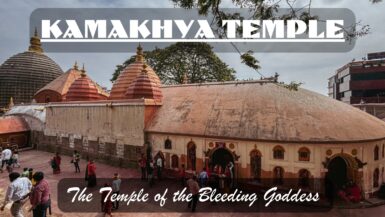
Kamakhya Temple: The Legendary Temple of the Bleeding Goddess
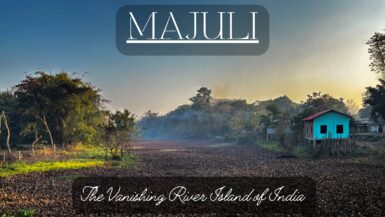
Majuli Island: The Vanishing River Island of India
Leave a reply cancel reply.
Your email address will not be published. Required fields are marked *
What are the Scientific explanation or archeological explanation behind the wonderful formation of Unakoti and Chabimura?? I am little bit curious for this
Beyond Wild Places
Your guide to the wilder side of life
A Travel Guide to Exploring Mizoram and Tripura
Mizoram and Tripura are often clumped together, not because they’re much alike, in fact they’re actually very different. However, they are both the least accessible and therefore, least explored states in Northeast India and both get very few visitors, rarely any foreigners.
Mizoram is perhaps the most isolated state, basically making you pass through Silchar in Assam to come in and out of the state by road. The state is home to some of the last untouched wilderness in India, with incredible green rolling hills for miles.
Tripura is an interesting state; a blend of cultures and religions, but is probably more ‘Indian’ than Mizoram and has a much similar vibe to Assam than to any other Northeastern state.
For exploring both Mizoram and Tripura by land, Silchar in Assam will be your base/start point and you may find yourself going back and forth from there a few times (as I did). Keep reading to find out how to explore these two states in Northeast India.
Disclaimer: This post contains affiliate links which means I get a commission if you buy a product through my link at no extra cost to you. By doing so, I can keep this blog going and continue to create helpful guides for you. Read more: Privacy Policy
Silchar, Assam
Silchar is a bustling town with a lively bazaar street in Assam state. There are plenty of hotels and restaurants around as it is also a major transport hub. This is the base from where you can easily explore both Mizoram and Tripura. Land transport into both of these states are very limited, and I found that using Silchar as a base was by far the easiest.
I stayed at Sewak Lodge in Silchar. The rooms are large, the location is perfect for multiple transport options, staff were nice and the WiFi is also really good: what more could you want? I found it actually cheaper to book it online for some reason than turning up without a booking. It’s pretty popular and can often be full.

How to get to Silchar
Silchar is quite an easy place to reach from various towns in Assam. There is a train station and bus station, with multiple transport options depending on where you’re coming from.
Originally, I came by train from Jorhat , with an overnight stop in Lumding (half way point between Jorhat and Silchar). I then took another train the next morning from Lumding to Silchar.
If you’re coming from Guwahati , there are a couple of trains that head to Silchar as well. You can look up Indian train info and timetables here .
From Silchar, you can explore both Mizoram and Tripura. However, unfortunately, it’ll likely mean a return trip to Silchar in between. The roads between Mizoram and Tripura are extremely remote and rarely used, and I couldn’t find any public transport connecting the town states.

Mizoram is right up there as one of the least visited states in all of India. It’s quite an isolated state with very little transport connections to anywhere other than Silchar in Assam.
There’s not a whole lot to do in Mizoram and it doesn’t necessarily have any typical ‘tourist sights’. I was often asked, “What are you doing here?”. Still, the green rolling hills make the views spectacular from almost anywhere in the state and the people are very friendly.
English is extremely well spoken by most and many people will strike up a conversation with you either on the bus, in a sumo or on the street. They are genuinely curious and mostly want to know what you are doing in their state. Most people assumed I was either working or a Christian missionary and it took a bit of convincing to get them to understand that I was actually a real live tourist!
Still, I can recommend exploring a couple of places in the state, including the capital and some other towns further south.
Aizawl is a sprawling, modern city perched on the top of beautiful rolling hills. The capital of the state is a pretty clean, orderly and contemporary city centre if there ever was one in India (traffic even gives way to pedestrians!).
You’ll soon notice some differences between Mizoram and other parts of India. Women smoke openly in public, go for early morning runs in tights and walk around late at night without a hassle. In fact, a few local women told me on various occasions that I should feel 100% safe walking around, even at night or early in the morning, which was a refreshing change from other areas in India.
The Mizos are fiercely independent and believe that history somehow went wrong for them and perhaps they would have been better off separated from India. Interestingly, the Mizos share much more of their culture and traditions with ethnic groups in Myanmar and further north to the Chinese border. In fact, their ancestors migrated from Myanmar to the hills in Mizoram centuries ago and so many of them (probably mostly the older generation) don’t truly feel ‘Indian’.
There is limited industry in Mizoram and they have had to rely heavily on trade with neighbouring Bangladesh and Myanmar with very little infrastructure connecting them with the rest of India. Much of the economy is based on agriculture, yet surprisingly a lot of the hills are still covered in forest rather than crops which keeps the views spectacular.

Where I stayed
I stayed at Arini Hotel , recommended by Lonely Planet, and seems to be very well known in general. I found the staff to be so friendly and always up for a chat and the rooms are really large, I was happy to spend a few days there. Check availability here .
The food is a little overpriced, however, I found a lot of the restaurants in Aizawl were pretty similar.
How to get to Aizawl
I took a shared sumo from Silchar at 8am. There are multiple companies in Silchar and they all leave at either 8am or 7pm, it’s best to book the day before in order to get a decent seat. The drive took around nine hours, but the views were beautiful, especially once you crossed into Mizoram.
At the state border, foreigners need to register with the officer on duty there. He didn’t even know how to fill in the registry book for foreigners so I had to help him out a bit and I still don’t think he did it right! The official sign at the office says that foreigners still require a permit but that is untrue as of 2018 and only Indians from other states require an ILP.

Thenzawl was recommended to me as a pretty town. It’s on the way between Aizawl and Lunglei so it’s not too much of a hassle to stop for the night.
It’s most well-known for having some beautiful waterfalls nearby. If you’re visiting after the rain season then they should be full of water, but they were practically dry when I visited at the start of the year. It still offers some incredible nature and lovely picnic parks to explore.
Tuirihiau Falls is located just 5 kilometres south of Thenzawl and is considered the most beautiful of all the waterfalls in Mizoram. The uniqueness of this waterfall is that you can step inside from behind the falls when they’re flowing well.
Thenzawl has a good government-run Tourist Lodge if you want to stay the night. I found it really comfortable with private rooms and ensuite bathrooms. Restaurants are a little few and far between in town but the food at the Lodge was delicious and reasonably priced.
How to get to Thenzawl
From Aizawl, there is the State Transport Corporation (MST) bus and multiple sumo companies plying to Lunglei , the state’s second largest city. I chose to go with the bus and there were two leaving at 6am. They were mostly empty when I bought my ticket and only had around 15 people on it for the whole journey. They will stop half way in Thenzawl, to let you out if you let them know.
To leave Thenzawl, I took a sumo from Mim Restaurant where you’ll find the only transport counter. There are sumos leaving throughout the day but I took the first one at 6.30am to be safe.

Lunglei is the second largest town in Mizoram. The drive from Aizawl to Lunglei is simply spectacular, with incredible rolling hills in all directions.
There are beautiful national parks and wildlife sanctuary’s to the south of the city, however, with limited tourist infrastructure and being an independent traveller these places are a little inaccessible. I spent most of my time around Lunglei and admiring the views from different parts of town.
Hotel Elite in Lunglei is perhaps one of the best places I stayed in the Northeast. The owner is a very nice lady and the food was also very good. However, the view from the windows and balcony of the rooms is exceptional and I’m not sure I’ve ever had such a view from a hotel before, especially not a budget hotel for 600 INR per night. I can highly recommend it. It’s a steep walk up from the main street in town.
How to get to Lunglei
You can get to Lunglei on either the public buses or sumos. There are frequent departures between Lunglei and Aizawl, stopping in Thenzawl. The buses tend to have very early morning departures like 6am, while sumos leave a little later and throughout the day.
To leave Lunglei back to Aizawl, there are around six sumo counters next to each other on the Lunglei-Thenzawl Road. They leave throughout the day at around 6.30am, 10am, 12pm and 2pm, you can usually get a ticket on the day without pre-booking.
Note: Don’t plan on travelling in Mizoram on a Sunday. All transport stops on this rest day, with most of the population being Christian. It means you might have to spend the day in your hotel, with very few other shops open.

Tripura actually boasts a few beautiful tourist sights that are worth taking the time to explore. It’s a stark contrast to Mizoram, with less beautiful scenery but some interesting attractions. Tripura is also much more similar to Assam and the rest of India than Mizoram, with the bustling capital Agartala. However, it’s bordered on three sides by Bangladesh and its also home to some fascinating tribal groups.
The tourist offices and lodges all offer newly printed brochures and information on the state, but most of the sights are easily accessible on your own as well. Being a small state, most of the sights can be reached from Agartala quite easily.
Agartala, the state’s capital, is by no means a large city. It definitely has a small town vibe and is very walkable, although bustling enough to remind you that you’re in India.
The main attraction in Agartala is the Ujjayanta Palace , which houses the State Museum . It was so much more impressive than I had imagined and it’s definitely worth the 150 INR entrance ticket. It gives a nice detailed history and general information about Tripura but also the Northeast region as a whole with some beautifully displayed artefacts.

For my first night in the city I stayed at Hotel Welcome Palace , recommended by Lonely Planet and one of the most popular and well known places in the city. I discovered they are not exactly a budget choice and start from around 1000 INR. It was a nice bit of luxury for a change and the only hot water shower I had in the state. Check availability here .
How I got around Tripura
From Agartala, the main tourist sites in the state are relatively accessible. The South Bus Station , south of the Battala Mahadev Temple roundabout and across the river, is the main transport hub for exploring the attractions in the south such as Neermahal and Udaipur.
There are buses, shared sumos and all sorts of other vehicles leaving in a constant stream and you only have to take one step near the place and you’ll have plenty of touts asking where you want to go.

Neermahal is a former royal palace built in the 1930s and although it might not be as extravagant as similar one’s in Rajasthan, it’s still a beautiful place to visit. It’s built in the middle of the lake and there are boats available to take you there. You can either hire a private boat yourself or pay per head and wait until it fills up.
I went at sunset, which was a perfect time for two reasons. First, there were plenty of other locals going at the same time so I was able to jump on with them and pay just 30 INR round trip for the boat. Second, the lighting was perfect and I would say the best time to go for photographs.
It’s empty and so there’s not much to see in the palace, but the architecture is nice and you are free to roam around the palace for an hour before taking the boat back.
How to get to Neermahal
There are frequent shared transport and buses leaving Agartala for Melaghar and back again. Melaghar is the main town where you can find the Neermahal palace. You can easily walk from where the bus drops you to the lake or take a tuk tuk.
In Melaghar, you only have to wait on the main street for a couple of minutes before a bus or other form of transport will come past for Agartala.
Just 150 metres away from the boat dock for Neermahal is the Tourist Lodge . You can stay for 700 INR for a single room. They also have food available which was delicious too. The manager is nice and handed me every brochure ever printed on tourism in Tripura that he found in his cabinet before I left!

Udaipur and Tripura Sundari Temple
Tripura Sundari temple is more than 500 years old and is one of the holiest Hindu shrines in the entire region. It’s still common practice to slaughter goats at the temple as a sacrifice, and many people come to bathe in the water of the lake. To be honest, it’s not very spectacular and despite it appearing on Tripura’s ‘must see’ attractions I wouldn’t go out of your way to see it, unless you time it with a religious ceremony or festival or are a Hindu yourself.
How to get to Udaipur
There are frequent buses leaving Agartala for Udaipur and vice versa, the journey only takes about two hours one way so you can see the Tripura Sundari Temple on a day trip from Agartala. Once in Udaipur you can take a shared autorickshaw for 20 INR to the temple.

Kailashahar and Unakoti
Unakoti archaeological site is a pilgrimage place for worshippers of Lord Shiva. The rock carvings date back to the 7 th and 9 th century without any real evidence to suggest why or how. Sadly, a lot of the smaller rock-cut carvings have been defaced over the years. However, the larger ones are extremely impressive and are not something you will see anywhere else in India, adding to the intrigue.
The site is also free for both Indians and foreigners (although I’m not sure how long that will last) and it’s a very popular place for dignitaries and officials to visit when in the Northeast region.
Kailashahar is the main town from where you can explore Unakoti, located right on the border with Bangladesh. Unakoti Rock Carvings are around 10km from town and you’ll have to take an auto rickshaw to reach it.
At the moment, it’s a very underexplored place in the Northeast and I was an absolute celebrity for the one night I stayed in Kailashahar. Every second person stopped me to ask where I was from. I even met young girls in college who had never seen a white woman in person before! People were still relatively friendly, but it was a tiring place to spend time as a foreigner.

I stayed at the government Tourist Lodge in Kailashahar for 800 INR per night. I arrived in the morning and the lodge manager spoke zero English and kept shaking his head when I asked for a room.
He pointed to a sign that said all guests must pre-book online (which I hadn’t needed to for other tourist lodges). After standing my ground and not moving for a while, he finally called the only local guide who speaks English who came to translate and finally, I was given a room!
The guide, Rahul, told me there was actually a hotel in town called Hotel Nirmala , where you can also stay as a tourist. Rahul is available to hire as a guide for Unakoti if you wish (every local will know him, just ask around). Otherwise, you can explore the archaeological site on your own.
How to get to Unakoti
I caught the train from Agartala (the same line that goes to Silchar) and got off at Kumarghat where there are shared autos and vans waiting to take you to Kailashahar , just 20km down the road. There are a few trains per day taking this route, I left on the earliest one at 6.15am.
I returned to Kumarghat the next day for the train to Silchar which passed through at 2pm (an hour later than scheduled). Shared autos and buses leave from Kailashahar for the station at Kumarghat when full.
Pin this post

Share this:

10 Best Cafes in Leh: Where to Eat in Ladakh

A Complete 10-Day Leh Ladakh Itinerary

A Travel Guide to Aru Valley in Kashmir

Ultimate North India Itinerary: Kashmir, Ladakh & Himachal Pradesh in 1 Month
Leave a reply cancel reply, discover more from beyond wild places.
Subscribe now to keep reading and get access to the full archive.
Type your email…
Continue reading

- Screen Reader Access
- 0381 232 5930
- A+ A A-


Tripura: Package Tours
- Screen Reader


IMAGES
VIDEO
COMMENTS
Unakoti Tourist Lodge. Unakoti lies 178 km to the northeast from Agartala which has the closest airport, 8 km to the east from Kailashahar, district headquarters of Unakoti district, 148 km to the south-east from Silchar. The nearest railway station is 19.6 km away at Dharmanagar railway station on the Lumding-Sabroom section. From ...
There is a Tripura Government Tourist Lodge (Unakoti Tourist Lodge) at Kailashahar. Unakoti is about 10km from the tourist lodge. The rates are quite reasonable too with Rs800 for a double-bedded room and Rs950 for a deluxe AC room. There are a number of hotels and guest houses at Dharmanagar as well. We stayed at Dharmanagar in Hotel Panchabati.
Unakoti. Diwali Festival. Baramura Eco Park. Jampui Hill. Neermahal Water Palace. Chaturdash Devta Temple. ... Rural tourism is a tourism that focuses on activel.... ExploreTripura. Trekking. JetSki. Paragliding. HouseBoat. ... Eden Tourist Lodge ₹1,680 / Night (2 Reviews) Explore Tour . TTDCL Accommodation .
Reviewed November 29, 2018. frontdesk was responsive but sometimes you have to keep asking to get work done. Stay was quite comfortable. We wanted to checkout early and they had the bill ready and no hassles. Even when Unakoti is about 20 Km away from Kailashahar. This is the most ideal place to stay for a day trip to Unakoti and back.
Unakoti Tourist Lodge, Kailashahar, Tripura: See 7 traveller reviews, user photos and best deals for Unakoti Tourist Lodge, ranked #1 of 2 Kailashahar, Tripura specialty lodging, rated 2 of 5 at Tripadvisor.
Unakoti Tourist Lodge in Kailashahar, India: View Tripadvisor's 7 unbiased reviews, photos, and special offers for Unakoti Tourist Lodge, #1 out of 3 Kailashahar specialty lodging.
At Kailashahar, the only feasible option is Tripura Tourism's Unakoti Tourist Lodge. By contrast, Dharmanagar offers more choices of accommodation, such as Lokenath Guest House, Hotel J C Plaza, Hotel Panchabati, and Hotel Unakoti. However, if you are visiting Dharmanagar during Kali Puja/Diwali, finding a room will be next to impossible.
A prime tourist spot in Tripura, Unakoti is an ancient pilgrimage centre, attracting tourists and devotees from far and wide.. Unakoti is where India's heritage stores its carvings and sculptures of gods and goddesses. For such a storehouse of religious and spiritual importance, it is only justified that the place also be the house to lush green flora and full of natural beauty.
Unakoti Tourist Lodge, Kailashahar: See 7 traveller reviews, candid photos, and great deals for Unakoti Tourist Lodge, ranked #1 of 3 Speciality lodging in Kailashahar and rated 2.5 of 5 at Tripadvisor.
Ask amit d about Unakoti Tourist Lodge. 9 Thank amit d . This review is the subjective opinion of a Tripadvisor member and not of Tripadvisor LLC. Tripadvisor performs checks on reviews as part of our industry-leading trust & safety standards. Read our transparency report to learn more.
Unakoti has 'Unakoti Tourist Lodge' run by Tripura tourism. At Dharmanagar you can stay at 'Uttermegh Tourist Lodge' or at "Hotel Pachabati" which is a good private hotel offering comfortable AC rooms. This is nice, clean and conveniently located. Since accommodation is limited it is wiser to go with prior booking.
Tourists can stay in a government tourist lodge (Unakoti Tourist Lodge) at Kailashahar approximately about 11 km from Unakoti Hills. The rates are quite reasonable starting from Rs 800. There are also a number of hotels and guest houses at Dharmanagar as well like Hotel Sun and Hotel Unakuti. What is the best time to visit Unakoti?
Unakoti is probably the best-known destination in the Tripura Tourist Map. I remember it was featured in Surabhi once, back in the 90s. I don't think still many people are visiting these monuments but at least I think it is a more familiar name compared to the likes of Pilak and Chabimura. So, when I planned to finally visit Tripura, I decided to make it the first stop.
Hotels near Unakoti Rock Carvings, Agartala on Tripadvisor: Find 10 traveller reviews, 29 candid photos, and prices for 5 hotels near Unakoti Rock Carvings in Agartala, India. ... "Juri Toursist Lodge, run by Tripura Government Tourism Department is situated right at the heart of Dharmanagar Town. Everything like Hotel, market, Food shop is ...
Unakoti Butifull tourist places Agartala to kumarghat Railway station Drop Car booking Namber Seven Daboll 0 Five Daboll six four eight one six. ... Hotels near Unakoti: (7.04 km) Unakoti Tourist Lodge (11.79 km) SPOT ON 63845 Hotel North Continental (12.43 km) Hotel J C Plaza (14.36 km) Juri Tourist Lodge
Hotels near Unakoti: (4.40 mi) Unakoti Tourist Lodge (7.37 mi) SPOT ON 63845 Hotel North Continental (7.77 mi) Hotel J C Plaza (8.98 mi) Juri Tourist Lodge (3.58 mi) Circuit House; View all hotels near Unakoti on Tripadvisor
The Unakoti Tourist Lodge is an affordable stay option which offers all basic amenities including home-style food and air conditioned rooms. The hotel is located near the Kailashahar Lake and can be reached by taking an auto. Another option is the Nirmala Hotel, which is a cosy place with comfortable rooms. ...
Unakoti itself does not have hotels. You need to stay either at Kailashahar or Dharmanagar. At Kailashahar, the only feasible option is Tripura Tourism's Unakoti Tourist Lodge. By contrast, Dharmanagar offers more choices of accommodation, such as Lokenath Guest House, Hotel J C Plaza, Hotel Panchabati, and Hotel Unakoti. A sculpted Nandi.
Hi, I'm Unakoti Tourist Lodge. Hotel; Unakuti Tourist Lodge Kailashahar Not rated 0 Review from ₹1,344.00 /night. View all (1) Get Updates & More. Thoughtful thoughts to your inbox. Subscribe NEED HELP? Call Us 0381 232 5930 . Email Us ...
Unakoti Where I stayed. I stayed at the government Tourist Lodge in Kailashahar for 800 INR per night. I arrived in the morning and the lodge manager spoke zero English and kept shaking his head when I asked for a room. He pointed to a sign that said all guests must pre-book online (which I hadn't needed to for other tourist lodges). After ...
Day-4: Started from Unakoti Tourist Lodge, Kailashahar - visit Khumulwng Eco Park - night halt at Geetanjali Tourism Guest House, Kunajan, Agartala - Day-5: - See-off to Agartala Airport/ Railway Station. Rs. 6,800/- per head: Rs. 6,000/- per head: 4. Weekend Package Tour: